Natural Gas Engine Technologies: Challenges and Energy Sustainability Issue
Abstract
1. Introduction
2. Natural-Gas Resources: Global Perspective
2.1. Proven Natural-Gas Reserves
2.2. Global Potential Reserves
2.3. Current Production Capacity and Consumption
2.4. Natural Gas in the Transportation Sector
3. Natural-Gas Fueling Infrastructure
3.1. Types of Refueling Station
3.2. Natural Gas Quality
3.3. Fuel Treatment and Distribution
3.4. Fuel Storage and Range
3.5. Natural Gas from Other Sources (Renewable CNG and Biomethane)
4. Natural-Gas Engines and Their Limitations
4.1. CNG in Spark-Ignition Engines
4.1.1. Mixture-Aspirated SI Engine
4.1.2. Spark-Ignition Direct-Injection Engines
4.2. Performance and Emission Optimization Strategies of CNG Fuel in the Latest SI Engines
4.2.1. Effect of Compression Ratio
4.2.2. Effect of Lean Charge Strategy
4.2.3. Effect of Injection Timing and Injection Pressure
4.2.4. Effect of Ignition Timing and Ignition Energy Control
4.2.5. Effect of Boost Pressure
4.2.6. Effect of EGR
4.2.7. Effect of Valve Lift and Valve Timing
4.2.8. Effect of Fuel Blending
4.3. CNG in CI Engines
5. Conclusions and Perspectives
Author Contributions
Funding
Acknowledgments
Conflicts of Interest
References
- Hesterberg, T.; Bunn, W.; Lapin, C. An evaluation of criteria for selecting vehicles fueled with diesel or compressed natural gas. Sustain. Sci. Pract. Policy 2009, 5, 20–30. [Google Scholar] [CrossRef]
- Thipse, S.S.; Sonawane, S.B.; D’Souza, A.F.; Rairikar, S.D.; Kavathekar, K.K.; Marathe, N.V. Injection Strategies, Optimization and Simulation Techniques on DI CNG Technology; SAE Technical Paper No. 2015-26-0046; SAE International: Warrendale, PA, USA, 2015. [Google Scholar]
- Soldo, B.; Potočnik, P.; Šimunović, G.; Šarić, T.; Govekar, E. Improving the residential natural gas consumption forecasting models by using solar radiation. Energy Build. 2014, 69, 498–506. [Google Scholar] [CrossRef]
- Yue, T.; Chai, F.; Hu, J.; Jia, M.; Bao, X.; Li, Z.; He, L.; Zu, L. Gaseous emissions from compressed natural gas buses in urban road and highway tests in China. J. Environ. Sci. 2016, 48, 193–199. [Google Scholar] [CrossRef] [PubMed]
- Ahmadi, P.; Chapoy, A.; Tohidi, B. Density, speed of sound and derived thermodynamic properties of a synthetic natural gas. J. Nat. Gas Sci. Eng. 2017, 40, 249–266. [Google Scholar] [CrossRef]
- AFDC. Natural gas vehicles. In Alternative Fuels Data Center; US Department of Energy: Washington, DC, USA, 2017. [Google Scholar]
- FMI. Automotive natural gas vehicle market: Global industry analysis and opportunity assessment 2015–2025. In Future Market Insites; FMI: Washington, DC, USA, 2017. [Google Scholar]
- Bhandari, K.; Bansal, A.; Shukla, A.; Khare, M. Performance and emissions of natural gas fueled internal combustion engine: A review. J. Sci. Ind. Res. 2005, 64, 333–338. [Google Scholar]
- Cho, H.M.; He, B.-Q. Spark ignition natural gas engines—A review. Energy Convers. Manag. 2007, 48, 608–618. [Google Scholar] [CrossRef]
- Bakar, R.; Ismail, A.R. Green engines development using compressed natural gas as an alternative fuel: A review. Am. J. Environ. Sci. 2009, 5, 1–11. [Google Scholar]
- Semin, R.A.B. A technical review of compressed natural gas as an alternative fuel for internal combustion engines. Am. J. Eng. Appl. Sci 2008, 1, 302–311. [Google Scholar]
- Khan, M.I.; Yasmeen, T.; Khan, M.I.; Farooq, M.; Wakeel, M. Research progress in the development of natural gas as fuel for road vehicles: A bibliographic review (1991–2016). Renew. Sustain. Energy Rev. 2016, 66, 702–741. [Google Scholar] [CrossRef]
- Matsuo, Y.; Yanagisawa, A.; Yamashita, Y. A global energy outlook to 2035 with strategic considerations for Asia and Middle East energy supply and demand interdependencies. Energy Strategy Rev. 2013, 2, 79–91. [Google Scholar] [CrossRef]
- Su, M.; Zhang, M.; Lu, W.; Chang, X.; Chen, B.; Liu, G.; Hao, Y.; Zhang, Y. ENA-based evaluation of energy supply security: Comparison between the Chinese crude oil and natural gas supply systems. Renew. Sustain. Energy Rev. 2017, 72, 888–899. [Google Scholar] [CrossRef]
- Mahmood, A.; Javaid, N.; Zafar, A.; Ali Riaz, R.; Ahmed, S.; Razzaq, S. Pakistan’s overall energy potential assessment, comparison of LNG, TAPI and IPI gas projects. Renew. Sustain. Energy Rev. 2014, 31, 182–193. [Google Scholar] [CrossRef]
- Shaikh, F.; Ji, Q.; Fan, Y.; Shaikh, P.H.; Uqaili, M.A. Modelling an optimal foreign natural gas import scheme for China. J. Nat. Gas Sci. Eng. 2017, 40, 267–276. [Google Scholar] [CrossRef]
- Kerzmann, T.L.; Buxton, G.A.; Preisser, J. A computer model for optimizing the location of natural gas fueling stations. Sustain. Energy Technol. Assess. 2014, 7, 221–226. [Google Scholar] [CrossRef]
- Peters, J.C. Natural gas and spillover from the us clean power plan into the Paris agreement. Energy Policy 2017, 106, 41–47. [Google Scholar] [CrossRef]
- Pourhoseini, S.H.; Asadi, R. An experimental study on thermal and radiative characteristics of natural gas flame in different equivalence ratios by chemiluminescence and IR photography methods. J. Nat. Gas Sci. Eng. 2017, 40, 126–131. [Google Scholar] [CrossRef]
- WEC. Energy resource: Gas. In World Energy; World Energy council: London, UK, 2016. [Google Scholar]
- Wood, D.A.; Nwaoha, C.; Towler, B.F. Gas-to-liquids (GTL): A review of an industry offering several routes for monetizing natural gas. J. Nat. Gas Sci. Eng. 2012, 9, 196–208. [Google Scholar] [CrossRef]
- Vivoda, V. LNG import diversification in Asia. Energy Strategy Rev. 2014, 2, 289–297. [Google Scholar] [CrossRef]
- Zhang, Q.; Li, Z.; Wang, G.; Li, H. Study on the impacts of natural gas supply cost on gas flow and infrastructure deployment in China. Appl. Energy 2016, 162, 1385–1398. [Google Scholar] [CrossRef]
- Kumar, S.; Kwon, H.-T.; Choi, K.-H.; Hyun Cho, J.; Lim, W.; Moon, I. Current status and future projections of LNG demand and supplies: A global prospective. Energy Policy 2011, 39, 4097–4104. [Google Scholar] [CrossRef]
- Kumar, S.; Kwon, H.-T.; Choi, K.-H.; Lim, W.; Cho, J.H.; Tak, K.; Moon, I. LNG: An eco-friendly cryogenic fuel for sustainable development. Appl. Energy 2011, 88, 4264–4273. [Google Scholar] [CrossRef]
- Ruble, I. European union energy supply security: The benefits of natural gas imports from the eastern Mediterranean. Energy Policy 2017, 105, 341–353. [Google Scholar] [CrossRef]
- Al-Sobhi, S.A.; Elkamel, A. Simulation and optimization of natural gas processing and production network consisting of LNG, GTL, and methanol facilities. J. Nat. Gas Sci. Eng. 2015, 23, 500–508. [Google Scholar] [CrossRef]
- BP. BP Statistical Review of World Energy; BP: London, UK, 2016. [Google Scholar]
- Siddig, K.; Grethe, H. No more gas from Egypt? Modeling offshore discoveries and import uncertainty of natural gas in Israel. Appl. Energy 2014, 136, 312–324. [Google Scholar] [CrossRef]
- Kang, Z. Natural gas supply-demand situation and prospect in China. Nat. Gas Ind. B 2014, 1, 103–112. [Google Scholar] [CrossRef]
- Leather, D.T.B.; Bahadori, A.; Nwaoha, C.; Wood, D.A. A review of Australia’s natural gas resources and their exploitation. J. Nat. Gas Sci. Eng. 2013, 10, 68–88. [Google Scholar] [CrossRef]
- Economides, M.J.; Oligney, R.E.; Lewis, P.E. U.S. Natural gas in 2011 and beyond. J. Nat. Gas Sci. Eng. 2012, 8, 2–8. [Google Scholar] [CrossRef]
- Song, Y.; Cheng, C.; Zhao, J.; Zhu, Z.; Liu, W.; Yang, M.; Xue, K. Evaluation of gas production from methane hydrates using depressurization, thermal stimulation and combined methods. Appl. Energy 2015, 145, 265–277. [Google Scholar] [CrossRef]
- Chong, Z.R.; Yang, S.H.B.; Babu, P.; Linga, P.; Li, X.-S. Review of natural gas hydrates as an energy resource: Prospects and challenges. Appl. Energy 2016, 162, 1633–1652. [Google Scholar] [CrossRef]
- Soldo, B. Forecasting natural gas consumption. Appl. Energy 2012, 92, 26–37. [Google Scholar] [CrossRef]
- Fei, Q.; Guarnieri, M.T.; Tao, L.; Laurens, L.M.L.; Dowe, N.; Pienkos, P.T. Bioconversion of natural gas to liquid fuel: Opportunities and challenges. Biotechnol. Adv. 2014, 32, 596–614. [Google Scholar] [CrossRef] [PubMed]
- Bahadori, A. Chapter 1—overview of natural gas resources. In Natural Gas Processing; Gulf Professional Publishing: Boston, MA, USA, 2014; pp. 1–22. [Google Scholar]
- Shaffer, B. Natural gas supply stability and foreign policy. Energy Policy 2013, 56, 114–125. [Google Scholar] [CrossRef]
- Anderson, B.E.; Uz, V. Compressed natural gas as a feasible replacement fuel for U.S. Transportation. J. Def. Model. Simul. 2014, 12, 67–78. [Google Scholar] [CrossRef]
- Nwaoha, C.; Wood, D.A. A review of the utilization and monetization of Nigeria’s natural gas resources: Current realities. J. Nat. Gas Sci. Eng. 2014, 18, 412–432. [Google Scholar] [CrossRef]
- Egging, R.; Pichler, A.; Kalvø, Ø.I.; Walle–Hansen, T.M. Risk aversion in imperfect natural gas markets. Eur. J. Oper. Res. 2017, 259, 367–383. [Google Scholar] [CrossRef]
- Honore, A. European Natural Gas Demand, Supply, and Pricing: Cycles, Seasons, and the Impact of LNG Price Arbitrage; Oxford University Press: Oxford, UK, 2011. [Google Scholar]
- Dilaver, Ö.; Dilaver, Z.; Hunt, L.C. What drives natural gas consumption in Europe? Analysis and projections. J. Nat. Gas Sci. Eng. 2014, 19, 125–136. [Google Scholar] [CrossRef]
- Eurogas. Eurogas Statistical Report 2015; Eurogas: Brussels, Belgium, 2016. [Google Scholar]
- Holz, F.; von Hirschhausen, C.; Kemfert, C. A strategic model of European gas supply (gasmod). Energy Econ. 2008, 30, 766–788. [Google Scholar] [CrossRef]
- Aloui, R.; Aïssa, M.S.B.; Hammoudeh, S.; Nguyen, D.K. Dependence and extreme dependence of crude oil and natural gas prices with applications to risk management. Energy Econ. 2014, 42, 332–342. [Google Scholar] [CrossRef]
- Ríos-Mercado, R.Z.; Borraz-Sánchez, C. Optimization problems in natural gas transportation systems: A state-of-the-art review. Appl. Energy 2015, 147, 536–555. [Google Scholar] [CrossRef]
- Kafood, A.H. CNG application in Qatar. In Proceedings of the International Petroleum Technology Conference (IPTC 2014), Bangkok, Thailand, 14–16 November 2014. [Google Scholar]
- Wang, Q.; Chen, X.; Jha, A.N.; Rogers, H. Natural gas from shale formation—The evolution, evidences and challenges of shale gas revolution in united states. Renew. Sustain. Energy Rev. 2014, 30, 1–28. [Google Scholar] [CrossRef]
- Brigida, M. The switching relationship between natural gas and crude oil prices. Energy Econ. 2014, 43, 48–55. [Google Scholar] [CrossRef]
- Koh, D.-Y.; Kang, H.; Lee, J.-W.; Park, Y.; Kim, S.-J.; Lee, J.; Lee, J.Y.; Lee, H. Energy-efficient natural gas hydrate production using gas exchange. Appl. Energy 2016, 162, 114–130. [Google Scholar] [CrossRef]
- de Melo-Martín, I.; Hays, J.; Finkel, M.L. The role of ethics in shale gas policies. Sci. Total Environ. 2014, 470–471, 1114–1119. [Google Scholar] [CrossRef] [PubMed]
- Fernández, R.; Palazuelos, E. The future of Russian gas exports to east Asia: Feasibility and market implications. Futures 2011, 43, 1069–1081. [Google Scholar] [CrossRef]
- Asche, F.; Oglend, A.; Osmundsen, P. Gas versus oil prices the impact of shale gas. Energy Policy 2012, 47, 117–124. [Google Scholar] [CrossRef]
- Bazilian, M.; Brandt, A.R.; Billman, L.; Heath, G.; Logan, J.; Mann, M.; Melaina, M.; Statwick, P.; Arent, D.; Benson, S.M. Ensuring benefits from north American shale gas development: Towards a research agenda. J. Unconv. Oil Gas Resour. 2014, 7, 71–74. [Google Scholar] [CrossRef]
- US Energy Information Administration. International Energy Outlook 2016; US Energy Information Administration: Washington, DC, USA, 2016.
- Moryadee, S.; Gabriel, S.A.; Avetisyan, H.G. Investigating the potential effects of U.S. LNG exports on global natural gas markets. Energy Strategy Rev. 2014, 2, 273–288. [Google Scholar] [CrossRef]
- Fukui, R.; Greenfield, C.; Pogue, K.; van der Zwaan, B. Experience curve for natural gas production by hydraulic fracturing. Energy Policy 2017, 105, 263–268. [Google Scholar] [CrossRef]
- Arora, V.; Cai, Y. U.S. Natural gas exports and their global impacts. Appl. Energy 2014, 120, 95–103. [Google Scholar] [CrossRef]
- Heidari, H.; Katircioglu, S.T.; Saeidpour, L. Natural gas consumption and economic growth: Are we ready to natural gas price liberalization in Iran? Energy Policy 2013, 63, 638–645. [Google Scholar] [CrossRef]
- Clark, D.E.; Dybicz, C.; Hanson, A.; Nourzad, F. “No shut-off” policies and natural gas consumption. Resour. Energy Econ. 2017, 48, 19–29. [Google Scholar] [CrossRef]
- Dong, X.; Pi, G.; Ma, Z.; Dong, C. The reform of the natural gas industry in the Republic of China. Renew. Sustain. Energy Rev. 2017, 73, 582–593. [Google Scholar] [CrossRef]
- Cabalu, H. Indicators of security of natural gas supply in Asia. Energy Policy 2010, 38, 218–225. [Google Scholar] [CrossRef]
- Ogunlowo, O.O.; Bristow, A.L.; Sohail, M. Developing compressed natural gas as an automotive fuel in Nigeria: Lessons from international markets. Energy Policy 2015, 76, 7–17. [Google Scholar] [CrossRef]
- Von Rosenstiel, D.P.; Heuermann, D.F.; Hüsig, S. Why has the introduction of natural gas vehicles failed in Germany?—Lessons on the role of market failure in markets for alternative fuel vehicles. Energy Policy 2015, 78, 91–101. [Google Scholar] [CrossRef]
- International Energy Agency. Mid Term Market Report 2015; International Energy Agency: Paris, France, 2015. [Google Scholar]
- Xian, H.; Karali, B.; Colson, G.; Wetzstein, M.E. Diesel or compressed natural gas? A real options evaluation of the U.S. Natural gas boom on fuel choice for trucking fleets. Energy 2015, 90, 1342–1348. [Google Scholar] [CrossRef]
- Curran, S.J.; Wagner, R.M.; Graves, R.L.; Keller, M.; Green, J.B., Jr. Well-to-wheel analysis of direct and indirect use of natural gas in passenger vehicles. Energy 2014, 75, 194–203. [Google Scholar] [CrossRef]
- Arteconi, A.; Polonara, F. LNG as vehicle fuel and the problem of supply: The Italian case study. Energy Policy 2013, 62, 503–512. [Google Scholar] [CrossRef]
- Wang, H.; Fang, H.; Yu, X.; Wang, K. Development of natural gas vehicles in China: An assessment of enabling factors and barriers. Energy Policy 2015, 85, 80–93. [Google Scholar] [CrossRef]
- Paltsev, S.; Zhang, D. Natural gas pricing reform in China: Getting closer to a market system? Energy Policy 2015, 86, 43–56. [Google Scholar] [CrossRef]
- Hao, H.; Wang, H.; Ouyang, M.; Cheng, F. Vehicle survival patterns in China. Sci. Chin. Technol. Sci. 2011, 54, 625–629. [Google Scholar] [CrossRef]
- Hao, H.; Geng, Y.; Li, W.; Guo, B. Energy consumption and GHG emissions from China’s freight transport sector: Scenarios through 2050. Energy Policy 2015, 85, 94–101. [Google Scholar] [CrossRef]
- Ma, L.; Geng, J.; Li, W.; Liu, P.; Li, Z. The development of natural gas as an automotive fuel in china. Energy Policy 2013, 62, 531–539. [Google Scholar] [CrossRef]
- Li, J.; Dong, X.; Shangguan, J.; Hook, M. Forecasting the growth of china’s natural gas consumption. Energy 2011, 36, 1380–1385. [Google Scholar] [CrossRef]
- Halova Wolfe, M.; Rosenman, R. Bidirectional causality in oil and gas markets. Energy Econ. 2014, 42, 325–331. [Google Scholar] [CrossRef]
- Khan, M.I.; Yasmin, T. Development of natural gas as a vehicular fuel in Pakistan: Issues and prospects. J. Nat. Gas Sci. Eng. 2014, 17, 99–109. [Google Scholar] [CrossRef]
- Perry, D. Current Natural Gas Vehicle Statistics; NGV Global: Auckland, New Zealand, 2017. [Google Scholar]
- Holmala, J.; Isaksson, J. Metso-Supplied World’s Largest Biomass Gasification Plant Inaugurated in Finland; Metso Corporation: Helsinki, Finland, 2013. [Google Scholar]
- Engerer, H.; Horn, M. Natural gas vehicles: An option for Europe. Energy Policy 2010, 38, 1017–1029. [Google Scholar] [CrossRef]
- Kuby, M.; Capar, I.; Kim, J.-G. Efficient and equitable transnational infrastructure planning for natural gas trucking in the European union. Eur. J. Oper. Res. 2017, 257, 979–991. [Google Scholar] [CrossRef]
- Osorio-Tejada, J.L.; Llera-Sastresa, E.; Scarpellini, S. Liquefied natural gas: Could it be a reliable option for road freight transport in the EU? Renew. Sustain. Energy Rev. 2017, 71, 785–795. [Google Scholar] [CrossRef]
- Bilgin, M. Geopolitics of European natural gas demand: Supplies from Russia, Caspian and the Middle East. Energy Policy 2009, 37, 4482–4492. [Google Scholar] [CrossRef]
- Hao, H.; Liu, Z.; Zhao, F.; Li, W. Natural gas as vehicle fuel in China: A review. Renew. Sustain. Energy Rev. 2016, 62, 521–533. [Google Scholar] [CrossRef]
- DeVos, K. A Review of Compressed Natural Gas as a Viable Alternative Fuel for Passenger Vehicle, Spark Ignition, Four-Stroke Engines; Rensselaer Polytechnic Institute: Troy, NY, USA, 2014. [Google Scholar]
- Idris, S.; Abu Baker, R. An overview of compressed natural gas as an alternative fuel and Malaysian scenario. Eur. J. Sci. Res. 2009, 34, 6–15. [Google Scholar]
- Yeh, S. An empirical analysis on the adoption of alternative fuel vehicles: The case of natural gas vehicles. Energy Policy 2007, 35, 5865–5875. [Google Scholar] [CrossRef]
- Chen, S.P.; Xie, G.F.; Li, Q.Y.; Chang, K. Comparison among LNG, CNG and l-CNG filling stations. Gas Heat 2007, 7, 006. [Google Scholar]
- Sharafian, A.; Talebian, H.; Blomerus, P.; Herrera, O.; Mérida, W. A review of liquefied natural gas refueling station designs. Renew. Sustain. Energy Rev. 2017, 69, 503–513. [Google Scholar] [CrossRef]
- Gashighway. Available online: http://www.gashighway.net/ (accessed on 17 June 2017).
- Commission, E. Eu Launches Clean Fuel Strategy; European Commission: Bruxelles, Belgium, 2013. [Google Scholar]
- Chala, G.; Aziz, A.; Hagos, F. Combined effect of boost pressure and injection timing on the performance and combustion of CNG in a di spark ignition engine. Int. J. Automot. Technol. 2017, 18, 85–96. [Google Scholar] [CrossRef]
- Yang, B.; Xi, C.; Wei, X.; Zeng, K.; Lai, M.-C. Parametric investigation of natural gas port injection and diesel pilot injection on the combustion and emissions of a turbocharged common rail dual-fuel engine at low load. Appl. Energy 2015, 143, 130–137. [Google Scholar] [CrossRef]
- McTaggart-Cowan, G.P.; Jones, H.L.; Rogak, S.N.; Bushe, W.K.; Hill, P.G.; Munshi, S.R. The effects of high-pressure injection on a compression–ignition, direct injection of natural gas engine. J. Eng. Gas Turbines Power 2006, 129, 579–588. [Google Scholar] [CrossRef]
- Amrouche, F.; Benzaoui, A.; Harouadi, F.; Mahmah, B.; Belhamel, M. Compressed natural gas: The new alternative fuel for the algerian transportation sector. Procedia Eng. 2012, 33, 102–110. [Google Scholar] [CrossRef]
- Srinivasan, K.K.; Krishnan, S.R.; Singh, S.; Midkiff, K.C.; Bell, S.R.; Gong, W.; Fiveland, S.B.; Willi, M. The advanced injection low pilot ignited natural gas engine: A combustion analysis. J. Eng. Gas Turbines Power 2006, 128, 213–218. [Google Scholar] [CrossRef]
- Korakianitis, T.; Namasivayam, A.; Crookes, R. Natural-gas fueled spark-ignition (SI) and compression-ignition (ci) engine performance and emissions. Prog. Energy Combust. Sci. 2011, 37, 89–112. [Google Scholar] [CrossRef]
- De Carvalho, R.D.B.; Valle, R.M.; de Magalhães, F.E. Performance and Emission Analysis of the Turbocharged Spark-Ignition Engine Converted to Natural Gas; 0148-7191; SAE Technical Paper; SAE International: Warrendale, PA, USA, 2003. [Google Scholar]
- Jarrahian, A.; Aghel, B.; Heidaryan, E. On the viscosity of natural gas. Fuel 2015, 150, 609–618. [Google Scholar] [CrossRef]
- Ocelík, P.; Osička, J. The framing of unconventional natural gas resources in the foreign energy policy discourse of the Russian federation. Energy Policy 2014, 72, 97–109. [Google Scholar] [CrossRef]
- Liu, Z.; Norbeck, J.M.; Raju, A.S.K.; Kim, S.; Park, C.S. Synthetic natural gas production by sorption enhanced steam hydrogasification based processes for improving ch4 yield and mitigating CO2 emissions. Energy Convers. Manag. 2016, 126, 256–265. [Google Scholar] [CrossRef]
- Esfahani, S.; Baselizadeh, S.; Hemmati-Sarapardeh, A. On determination of natural gas density: Least square support vector machine modeling approach. J. Nat. Gas Sci. Eng. 2015, 22, 348–358. [Google Scholar] [CrossRef]
- Heidaryan, E.; Moghadasi, J.; Salarabadi, A. A new and reliable model for predicting methane viscosity at high pressures and high temperatures. J. Nat. Gas Chem. 2010, 19, 552–556. [Google Scholar] [CrossRef]
- Yousefi, S.H.; Azamifard, A.; Hosseini, S.-A.; Shamsoddini, M.-J.; Alizadeh, N. Toward a predictive model for predicting viscosity of natural and hydrocarbon gases. J. Nat. Gas Sci. Eng. 2014, 20, 147–154. [Google Scholar] [CrossRef]
- Skylogianni, E.; Novak, N.; Louli, V.; Pappa, G.; Boukouvalas, C.; Skouras, S.; Solbraa, E.; Voutsas, E. Measurement and prediction of dew points of six natural gases. Fluid Phase Equilib. 2016, 424, 8–15. [Google Scholar] [CrossRef]
- Mesquita, F.; Feitosa, F.; Do Carmo, F.; de Santiago-Aguiar, R.; de Sant’Ana, H. Viscosities and viscosity deviations of binary mixtures of biodiesel + petrodiesel (or n-hexadecane) at different temperatures. Braz. J. Chem. Eng. 2012, 29, 653–664. [Google Scholar] [CrossRef]
- Walsh, M.P. Property of fuels. In Car Lines; Michael, P., Ed.; Car Lines: Arlington, ND, USA, 2006. [Google Scholar]
- Acevedo, H.; Mantilla, J. Performance and emissions of a heavy duty diesel engine fuelled with palm oil biodiesel and premium diesel. Dyna 2011, 78, 152–158. [Google Scholar]
- Chong, C.T.; Hochgreb, S. Measurements of laminar flame speeds of liquid fuels: Jet-a1, diesel, palm methyl esters and blends using particle imaging velocimetry (PIV). Proc. Combust. Inst. 2011, 33, 979–986. [Google Scholar] [CrossRef]
- Dirrenberger, P.; Glaude, P.-A.; Bounaceur, R.; Le Gall, H.; da Cruz, A.P.; Konnov, A.; Battin-Leclerc, F. Laminar burning velocity of gasolines with addition of ethanol. Fuel 2014, 115, 162–169. [Google Scholar] [CrossRef]
- Glaude, P.-A.; Fournet, R.; Bounaceur, R.; Molière, M. Adiabatic flame temperature from biofuels and fossil fuels and derived effect on NOx emissions. Fuel Process. Technol. 2010, 91, 229–235. [Google Scholar] [CrossRef]
- Ahlvik, P. Natural gas. In Diesel NET; ECOpoint Inc.: Mississauga, ON, Canada, 2003. [Google Scholar]
- Mishra, S. Biogas from Wholesale Vegetable and Fruit Market Waste in the Indian Cities: Truely Sustainable and Renewable Transport Fuel; Green Cosmos Energy Solutions Pvt. Ltd.: Bangalore, India, 2012. [Google Scholar]
- Mazyan, W.; Ahmadi, A.; Ahmed, H.; Hoorfar, M. Market and technology assessment of natural gas processing: A review. J. Nat. Gas Sci. Eng. 2016, 30, 487–514. [Google Scholar] [CrossRef]
- Berstad, D.; Nekså, P.; Anantharaman, R. Low-temperature CO2 removal from natural gas. Energy Procedia 2012, 26, 41–48. [Google Scholar] [CrossRef]
- Peters, L.; Hussain, A.; Follmann, M.; Melin, T.; Hägg, M.B. CO2 removal from natural gas by employing amine absorption and membrane technology—A technical and economical analysis. Chem. Eng. J. 2011, 172, 952–960. [Google Scholar] [CrossRef]
- Rufford, T.E.; Smart, S.; Watson, G.C.Y.; Graham, B.F.; Boxall, J.; Diniz da Costa, J.C.; May, E.F. The removal of CO2 and N2 from natural gas: A review of conventional and emerging process technologies. J. Pet. Sci. Eng. 2012, 94–95, 123–154. [Google Scholar] [CrossRef]
- Alcheikhhamdon, Y.; Hoorfar, M. Natural gas quality enhancement: A review of the conventional treatment processes, and the industrial challenges facing emerging technologies. J. Nat. Gas Sci. Eng. 2016, 34, 689–701. [Google Scholar] [CrossRef]
- Faramawy, S.; Zaki, T.; Sakr, A.A.E. Natural gas origin, composition, and processing: A review. J. Nat. Gas Sci. Eng. 2016, 34, 34–54. [Google Scholar] [CrossRef]
- Ahmadian Behrooz, H. Managing demand uncertainty in natural gas transmission networks. J. Nat. Gas Sci. Eng. 2016, 34, 100–111. [Google Scholar] [CrossRef]
- Nagayama, D.; Horita, M. A network game analysis of strategic interactions in the international trade of russian natural gas through ukraine and belarus. Energy Econ. 2014, 43, 89–101. [Google Scholar] [CrossRef]
- Qu, Z.; Wang, Y.; Yue, H.; An, Y.; Wu, L.; Zhou, W.; Wang, H.; Su, Z.; Li, J.; Zhang, Y. Study on the natural gas pipeline safety monitoring technique and the time-frequency signal analysis method. J. Loss Prev. Process Ind. 2017, 47, 1–9. [Google Scholar] [CrossRef]
- Üster, H.; Dilaveroğlu, Ş. Optimization for design and operation of natural gas transmission networks. Appl. Energy 2014, 133, 56–69. [Google Scholar] [CrossRef]
- Ertas, A.; Anderson, E. Review of methanol and compressed natural gas (CNG) as alternative for transportation fuels. J. Energy Resour. Technol 1991, 113, 101. [Google Scholar] [CrossRef]
- Koza, D.F.; Ropke, S.; Boleda Molas, A. The liquefied natural gas infrastructure and tanker fleet sizing problem. Transp. Res. Part E Logist. Transp. Rev. 2017, 99, 96–114. [Google Scholar] [CrossRef]
- Shi, G.-H.; Jing, Y.-Y.; Wang, S.-L.; Zhang, X.-T. Development status of liquefied natural gas industry in china. Energy Policy 2010, 38, 7457–7465. [Google Scholar] [CrossRef]
- Wood, D.A. A review and outlook for the global LNG trade. J. Nat. Gas Sci. Eng. 2012, 9, 16–27. [Google Scholar] [CrossRef]
- Vivoda, V. Natural gas in Asia: Trade, markets and regional institutions. Energy Policy 2014, 74, 80–90. [Google Scholar] [CrossRef]
- Dorigoni, S.; Graziano, C.; Pontoni, F. Can LNG increase competitiveness in the natural gas market? Energy Policy 2010, 38, 7653–7664. [Google Scholar] [CrossRef]
- Dorigoni, S.; Portatadino, S. LNG development across Europe: Infrastructural and regulatory analysis. Energy Policy 2008, 36, 3366–3373. [Google Scholar] [CrossRef]
- Erdős, P. Have oil and gas prices got separated? Energy Policy 2012, 49, 707–718. [Google Scholar] [CrossRef]
- Wang, X.; Marongiu Porcu, M. The Potential of Compressed Natural Gas Transport in Asia. In Proceedings of the International Petroleum Technology Conference, Kuala Lumpur, Malaysia, 3–5 December 2008. [Google Scholar]
- Hafner, M.; Karbuz, S.; Esnault, B.; Andaloussi, H.E. Long-term natural gas supply to Europe: Import potential, infrastructure needs and investment promotion. Energy Environ. 2008, 19, 1131–1153. [Google Scholar] [CrossRef]
- Talus, K. Long-term natural gas contracts and antitrust law in the European union and the united states. J. World Energy Law Bus. 2011, 4, 260–315i. [Google Scholar] [CrossRef]
- Castillo, L.; Majzoub Dahouk, M.; Di Scipio, S.; Dorao, C.A. Conceptual analysis of the precooling stage for lng processes. Energy Convers. Manag. 2013, 66, 41–47. [Google Scholar] [CrossRef]
- Zhou, S.; Gao, J.; Yang, Y.; Li, B.; Petro, P. Development, problems and market share of the LNG industry in China. Int. Pet. Econ. 2013, 6, 3. [Google Scholar]
- Wang, Z.; Rao, L.; Yang, Y.; Gao, H. Natural gas vehicles will develop greatly in china. In Proceedings of the International Petroleum Technology Conference (IPTC 2013), Beijing, China, 26–28 March 2013. [Google Scholar]
- Medlock, K.B.; Jaffe, A.M.; O’Sullivan, M. The global gas market, LNG exports and the shifting us geopolitical presence. Energy Strategy Rev. 2014, 5, 14–25. [Google Scholar] [CrossRef]
- Paltsev, S. Scenarios for Russia’s natural gas exports to 2050. Energy Econ. 2014, 42, 262–270. [Google Scholar] [CrossRef]
- Birol, F. G7 energy ministerial meeting. In Proceedings of the G7 Energy Ministerial Meeting, Rome, Italy, 9–10 April 2017. [Google Scholar]
- Thomas, S.; Dawe, R.A. Review of ways to transport natural gas energy from countries which do not need the gas for domestic use. Energy 2003, 28, 1461–1477. [Google Scholar] [CrossRef]
- Wang, X.; Economides, A.M.; Porcu, M.M.; Economides, M.J. Compressed natural gas for Indonesia. In Proceedings of the Asia Pacific Oil and Gas Conference & Exhibition, Jakarta, Indonesia, 4–6 August 2009. [Google Scholar]
- Khan, M.I.; Yasmin, T.; Shakoor, A. Technical overview of compressed natural gas (CNG) as a transportation fuel. Renew. Sustain. Energy Rev. 2015, 51, 785–797. [Google Scholar] [CrossRef]
- Melaina, M.; Bremson, J. Refueling availability for alternative fuel vehicle markets: Sufficient urban station coverage. Energy Policy 2008, 36, 3233–3241. [Google Scholar] [CrossRef]
- Patrizio, P.; Leduc, S.; Chinese, D.; Dotzauer, E.; Kraxner, F. Biomethane as transport fuel—A comparison with other biogas utilization pathways in northern Italy. Appl. Energy 2015, 157, 25–34. [Google Scholar] [CrossRef]
- Salman, C.A.; Schwede, S.; Thorin, E.; Yan, J. Enhancing biomethane production by integrating pyrolysis and anaerobic digestion processes. Appl. Energy 2017, 204, 1074–1083. [Google Scholar] [CrossRef]
- Görling, M.; Larsson, M.; Alvfors, P. Bio-methane via fast pyrolysis of biomass. Appl. Energy 2013, 112, 440–447. [Google Scholar] [CrossRef]
- Ullah Khan, I.; Hafiz Dzarfan Othman, M.; Hashim, H.; Matsuura, T.; Ismail, A.F.; Rezaei-DashtArzhandi, M.; Wan Azelee, I. Biogas as a renewable energy fuel—A review of biogas upgrading, utilisation and storage. Energy Convers. Manag. 2017, 150, 277–294. [Google Scholar] [CrossRef]
- Patterson, T.; Esteves, S.; Dinsdale, R.; Guwy, A. An evaluation of the policy and techno-economic factors affecting the potential for biogas upgrading for transport fuel use in the UK. Energy Policy 2011, 39, 1806–1816. [Google Scholar] [CrossRef]
- Augelletti, R.; Conti, M.; Annesini, M.C. Pressure swing adsorption for biogas upgrading. A new process configuration for the separation of biomethane and carbon dioxide. J. Clean. Prod. 2017, 140, 1390–1398. [Google Scholar] [CrossRef]
- Pellegrini, L.A.; De Guido, G.; Langé, S. Biogas to liquefied biomethane via cryogenic upgrading technologies. Renew. Energy 2017, 124, 75–83. [Google Scholar] [CrossRef]
- Götz, M.; Lefebvre, J.; Mörs, F.; McDaniel Koch, A.; Graf, F.; Bajohr, S.; Reimert, R.; Kolb, T. Renewable power-to-gas: A technological and economic review. Renew. Energy 2016, 85, 1371–1390. [Google Scholar] [CrossRef]
- Castellani, B.; Rinaldi, S.; Morini, E.; Nastasi, B.; Rossi, F. Flue gas treatment by power-to-gas integration for methane and ammonia synthesis – energy and environmental analysis. Energy Convers. Manag. 2018, 171, 626–634. [Google Scholar] [CrossRef]
- Hassan, M.H.; Kalam, M.A.; Mahlia, T.I.; Aris, I.; Nizam, M.K.; Abdullah, S.; Ali, Y. Experimental test of a new compressed natural gas direct injection engine. Energy Fuels 2009, 23, 4981–4987. [Google Scholar] [CrossRef]
- Heywood, J.B. Internal Combustion Engine Fundamentals; McGraw Hill International: New York, NY, USA, 1988. [Google Scholar]
- Arcoumanis, C.; Kamimoto, T. Flow and Combustion in Reciprocating Engines; Springer Science & Business Media: Berlin, Germany, 2009. [Google Scholar]
- Willems, H.; Sierens, R. Modeling the initial growth of the plasma and flame kernel in SI engines. Trans. Am. Soc. Mech. Eng. J. Eng. Gas Turbines Power 2003, 125, 479–484. [Google Scholar] [CrossRef]
- Aleiferis, P.G.; Taylor, A.M.; Whitelaw, J.H.; Ishii, K.; Urata, Y. Cyclic Variations of Initial Flame Kernel Growth in a Honda Vtec-E Lean-Burn Spark-Ignition Engine; SAE Technical Paper 0148-7191; SAE International: Warrendale, PA, USA, 2000. [Google Scholar]
- Hagos, F. Combustion, Performance and Emissions Characteristics of Imitated Syngases in Direct-Injection Sparkigntion Engine. Ph.D. Thesis, Universiti Teknologi Petronas, Seri Iskandar, Malaysia, 2013. [Google Scholar]
- Gharehghani, A.; Hosseini, R.; Mirsalim, M.; Yusaf, T.F. A comparative study on the first and second law analysis and performance characteristics of a spark ignition engine using either natural gas or gasoline. Fuel 2015, 158, 488–493. [Google Scholar] [CrossRef]
- Ou, X.; Zhang, X. Life-cycle analyses of energy consumption and GHG emissions of natural gas-based alternative vehicle fuels in china. J. Energy 2013, 2013. [Google Scholar] [CrossRef]
- Aziz, A.R.A.; Shahzad, R. Combustion analysis of a CNG direct injection spark ignition engine. Int. J. Automot. Mech. Eng. 2010, 2, 157–170. [Google Scholar] [CrossRef]
- Chandra, R.; Vijay, V.; Subbarao, P.; Khura, T. Performance evaluation of a constant speed IC engine on CNG, methane enriched biogas and biogas. Appl. Energy 2011, 88, 3969–3977. [Google Scholar] [CrossRef]
- Sonthalia, A.; Rameshkumar, C.; Sharma, U.; Punganur, A.; Abbas, S. Combustion and performance characteristics of a small spark ignition engine fuelled with HCNG. J. Eng. Sci. Technol. 2015, 10, 404–419. [Google Scholar]
- Jahirul, M.I.; Masjuki, H.; Saidur, R.; Kalam, M.; Jayed, M.; Wazed, M. Comparative engine performance and emission analysis of CNG and gasoline in a retrofitted car engine. Appl. Therm. Eng. 2010, 30, 2219–2226. [Google Scholar] [CrossRef]
- Rezapour, K.; Mason, B.; Wood, A.S.; Ebrahimi, M. Bi-fuel SI engine model for analysis and optimization. Univ. J. Mech. Eng. 2014, 2, 71–82. [Google Scholar] [CrossRef]
- Poulton, M.L. Alternative Fuels for Road Vehicles; WIT Press: Southampton, UK, 1994. [Google Scholar]
- Ouellette, P. High pressure direct injection (HPDI) of natural gas in diesel engines. In Proceedings of the ANGVA 2000 Conference, Yokohama, Japan, 7–10 November 2000. [Google Scholar]
- Tadesse, G.; Aziz, A.R.A. Effect of Boost Pressure on Engine Performance and Exhaust Emissions in Direct-Injection Compressed Natural Gas CNG-DI) Spark Ignition Engine; SAE Technical Paper No. 2009-32-0135; SAE International: Warrendale, PA, USA, 2009. [Google Scholar]
- Tadesse, G. Effect of Boost Pressure on Performance, Combustion and Exhaust Emissions in Direct Injection Compressed Natural Gas (CNG) Engine. Master’s Thesis, University Teknologi Petronas, Perak, Malaysia, 2009. [Google Scholar]
- d’Ambrosio, S.; Spessa, E.; Vassallo, A.; Ferrera, M.; Peletto, C. Experimental Investigation of Fuel Consumption, Exhaust Emissions and Heat Release of a Small-Displacement Turbocharged CNG Engine; SAE Technical Paper 0148-7191; SAE International: Warrendale, PA, USA, 2006. [Google Scholar]
- Li, H. An Experimental and Analytical Examination of Gas Fuelled Spark Ignition Engine-Performance and Combustion; University of Calgary: Calgary, AB, Canada, 2004. [Google Scholar]
- Reynolds, C.C.O.; Evans, R.L.; Andreassi, L.; Cordiner, S.; Mulone, V. The Effect of Varying the Injected Charge Stoichiometry in a Partially Stratified Charge Natural Gas Engine; SAE Technical Paper 0148-7191; SAE International: Warrendale, PA, USA, 2005. [Google Scholar]
- Da Silveira, B.H.; Benvenuti, L.H.; Werninghaus, E.; Coelho, E.P.; Silva, C.D.; de Oliveira, F.R.; Silva, J.C.S. Development of a Concept Vehicle for Compressed Natural Gas; SAE Technical Paper 0148-7191; SAE International: Warrendale, PA, USA, 2004. [Google Scholar]
- Durell, E.; Allen, J.; Law, D.; Heath, J. Installation and Development of a Direct Injection System for a Bi-Fuel Gasoline and Compressed Natural Gas Engine. In Proceeding of the ANGVA 2000 Conference, Yokohama, Japan, 18–21 July 2000. [Google Scholar]
- Abid, F.H. Comparison of performance characteristics of ng and gasoline-fuelled single cylinder SI engine. Int. J. Comput. Appl. Sci. 2016, 1, 13–20. [Google Scholar]
- Melaika, M.; Dahlander, P. Experimental Investigation of Methane Direct Injection with Stratified Charge Combustion in Optical SI Single Cylinder Engine; SAE Technical Paper 0148-7191; SAE International: Warrendale, PA, USA, 2016. [Google Scholar]
- Ilves, R.; Olt, J. Study of prior art of spark ignition engine fuel supply system. Argon. Res. 2012, 10, 55–74. [Google Scholar]
- Stone, R. Introduction to Internal Combustion Engines; Palgrave Macmillan: London, UK, 2012. [Google Scholar]
- Mello, P.; Pelliza, G.; Cataluña, R.; da Silva, R. Evaluation of the maximum horsepower of vehicles converted for use with natural gas fuel. Fuel 2006, 85, 2180–2186. [Google Scholar] [CrossRef]
- Tuner, M. Combustion of Alternative Vehicle Fuels in Internal Combustion Engines; Report within Project; A Pre-Study to Prepare for Interdisciplinary Research on Future Alternative Transportation Fuels; Financed by The Swedish Energy Agency; Lund University: Lund, Sweden, 2016. [Google Scholar]
- Nice, K. How Fuel Injection Systems Work. 2001. Available online: https://www.howstuffworks.com/ (accessed on 17 June 2017).
- Loukanine, V.N.; Khatchiyan, A.S.; Shishlov, I.G.; Khamidullin, R.K. Analysis of different ways to develop low-emission natural gas engines. In Proceedings of the NGV 2000, Yokohama, Japan, 17–19 October 2000. [Google Scholar]
- Czerwinski, J.; Comte, P.; Zimmerli, Y. Investigations of the Gas Injection System on a HD-CNG-Engine; SAE Technical Paper 0148-7191; SAE International: Warrendale, PA, USA, 2003. [Google Scholar]
- Choi, M.; Lee, S.; Park, S. Numerical and experimental study of gaseous fuel injection for CNG direct injection. Fuel 2015, 140, 693–700. [Google Scholar] [CrossRef]
- Chiodi, M.; Berner, H.-J.; Bargende, M. Investigation on Different Injection Strategies in a Direct-Injected Turbocharged CNG-Engine; SAE Technical Paper 0148-7191; SAE International: Warrendale, PA, USA, 2006. [Google Scholar]
- Cox, G.; DelVecchio, K.; Hays, W.; Hiltner, J.; Nagaraj, R.; Emmer, C. Development of a Direct-Injected Natural Gas Engine System for Heavy-Duty Vehicles; Caterpillar, Inc.: Peoria, IL, USA, 2000. [Google Scholar]
- Hayashida, M.; Yamato, T.; Sekino, H.; Sugahara, K. Investigation of Performance and Fuel Distribution of a Direct Injection Gas Engine Using LIF Measurement; SAE Technical Paper 0148-7191; SAE International: Warrendale, PA, USA, 1999. [Google Scholar]
- Hassaneen, A.E.; Varde, K.S.; Bawady, A.H.; Morgan, A.-A. A Study of the Flame Development and Rapid Burn Durations in a Lean-Burn Fuel Injected Natural Gas SI Engine; SAE Technical Paper 0148-7191; SAE International: Warrendale, PA, USA, 1998. [Google Scholar]
- Heywood, J. Internal combustion ENGINE Fundamentals; McGraw-Hill Education: New York, NY, USA, 1988. [Google Scholar]
- Achleitner, E.; Bäcker, H.; Funaioli, A. Direct Injection Systems for Otto Engines; SAE Technical Paper 0148-7191; SAE International: Warrendale, PA, USA, 2007. [Google Scholar]
- Hagos, F.Y.; Aziz, A.R.A.; Sulaiman, S.A. Combustion characteristics of late injected CNG in a spark ignition engine under lean operating condition. J. Appl. Sci. 2012, 12, 2368. [Google Scholar] [CrossRef]
- Sahari, B.B.; Ali, Y.; Ahmadun, F.L.-R.; Abdullah, S.; Hassan, M.H.; Aris, I.; Abdullah, M.A.; Ahmad, M.F.; Chelliah, V.; Taha, Z. Development of a prototype compressed natural gas direct injection vehicle—A Malaysian experience. In Proceedings of the 12th IANGV Conference and Exhibition, Rome, Italy; 9–12 May 2010. [Google Scholar]
- Nijboer, M. The Contribution of Natural Gas Vehicles to Sustainable Transport; 2079-2581; International Energy Agency: Paris, France, 2010. [Google Scholar]
- Kalam, M.; Masjuki, H. An experimental investigation of high performance natural gas engine with direct injection. Energy 2011, 36, 3563–3571. [Google Scholar] [CrossRef]
- Zheng, J.; Wang, J.; Wang, B.; Huang, Z. Effect of the compression ratio on the performance and combustion of a natural-gas direct-injection engine. Proc. Inst. Mech. Eng. D-J. Automob. Eng. 2009, 223, 85–98. [Google Scholar] [CrossRef]
- Ibrahim, A.; Bari, S. Effect of varying compression ratio on a natural gas SI engine performance in the presence of EGR. Energy Fuels 2009, 23, 4949–4956. [Google Scholar] [CrossRef]
- Ramachandran, A.; Waghmare, A. Experimental investigation of the effect of compression ratio on the performance of a dedicated CNG engine. Int. Res. J. Eng. Technol. 2016, 3, 312–316. [Google Scholar]
- Damrongkijkosol, C.; Kerdsuwan, S. Experiment Study on Influence of Compression Ratio onto Performance and Emission of Compressed Natural Gas Retrofit Engine. Master’s Thesis, King Mongkut’s Institute of Technology, Bangkok, Thailand, 2006. [Google Scholar]
- Manivannan, A.; Chandrasekaran, S.; Ramprabhu, R. Lean Burn Natural Gas Spark Ignition Engine—An Overview; SAE Technical Paper 0148-7191; SAE International: Warrendale, PA, USA, 2003. [Google Scholar]
- Abbasi Atibeh, P.; Brear, M.J.; Dennis, P.A.; Orbaiz, P.J.; Watson, H.C. Lean limit combustion analysis for a spark ignition natural gas internal combustion engine. Combust. Sci. Technol. 2013, 185, 1151–1168. [Google Scholar] [CrossRef]
- Cartellieri, W.; Chmela, F.; Kapus, P.; Tatschl, R. Mechanisms leading to stable and efficient combustion in lean burn gas engines. In Proceedings of the International Symposium COMODIA, Yokohama, Japan, 11–14 July 1994. [Google Scholar]
- Aziz, A.R.A.; Anbese, Y.T.; Hagos, F.Y.; Heikal, M.R. Characteristics of early flame development in a direct-injection spark-ignition CNG engine fitted with a variable swirl control valve. Energies 2017, 10, 964. [Google Scholar] [CrossRef]
- Evans, R. Extending the lean limit of natural-gas engines. J. Eng. Gas Turbines Power 2009, 131, 032803. [Google Scholar] [CrossRef]
- Chen, S.K.; Beck, N.J. Gas Engine Combustion Principles and Applications; SAE Technical Paper 0148-7191; SAE International: Warrendale, PA, USA, 2001. [Google Scholar]
- Aljamali, S.; Abdullah, S.; Wan Mahmood, W.M.F.; Ali, Y. The effect of injection timings on performance and emissions of compressed natural-gas direct injection engine. J. Combust. 2016, 2016, 6501462. [Google Scholar] [CrossRef]
- Wasiu, A.B.; Aziz, A.R.A.; Heikal, M.R. The effect of injection timing on the performance of natural gas with a high carbon dioxide (CO2) content in a direct injection (di) gas engine. In MATEC Web of Conferences; EDP Sciences: Ulis, France, 2014; p. 02027. [Google Scholar]
- Zeng, K.; Huang, Z.; Liu, B.; Liu, L.; Jiang, D.; Ren, Y.; Wang, J. Combustion characteristics of a direct-injection natural gas engine under various fuel injection timings. Appl. Therm. Eng. 2006, 26, 806–813. [Google Scholar] [CrossRef]
- Liu, L.-X.; Huang, Z.-H.; Jiang, D.-M.; Ren, Y.; Wang, J.-H.; Wang, Q. Combustion characteristics of a direct injection natural gas engine under various fuel injection timings. Trans. CSICE 2005, 5, 14. [Google Scholar]
- Song, J.; Choi, M.; Kim, D.; Park, S. Combustion characteristics of methane direct injection engine under various injection timings and injection pressures. J. Eng. Gas Turbines Power 2017, 139, 082802. [Google Scholar] [CrossRef]
- Hagos, F.Y.; Aziz, A.R.A.; Sulaiman, S.A. Methane enrichment of syngas (H2/CO) in a spark-ignition direct-injection engine: Combustion, performance and emissions comparison with syngas and compressed natural gas. Energy 2015, 90, 2006–2015. [Google Scholar] [CrossRef]
- Hagos, F.Y.; Aziz, A.R.A.; Sulaiman, S.A. Syngas (H2/CO) in a spark-ignition direct-injection engine. Part 1: Combustion, performance and emissions comparison with CNG. Int. J. Hydrog. Energy 2014, 39, 17884–17895. [Google Scholar] [CrossRef]
- Firmansyah. Optimization of Injection Parameters in Compressed Natural Gas Direct Injection (CNG-DI) Spark Ignition Engine; Universiti Teknologi Petronas: Tronoh, Malaysia, 2007. [Google Scholar]
- Ehsan, M. Effect of spark advance on a gas run automotive spark ignition engine. J. Chem. Eng. 2010, 24, 42–49. [Google Scholar] [CrossRef]
- Bell, S.R. Natural Gas as a Transportation Fuel; SAE Technical Paper 0148-7191; SAE International: Warrendale, PA, USA, 1993. [Google Scholar]
- Dimopoulos, P.; Rechsteiner, C.; Soltic, P.; Laemmle, C.; Boulouchos, K. Increase of passenger car engine efficiency with low engine-out emissions using hydrogen–natural gas mixtures: A thermodynamic analysis. Int. J. Hydrog. Energy 2007, 32, 3073–3083. [Google Scholar] [CrossRef]
- Khan, M.A.H.; Qidwai, M.O.; Chausalkar, A. Effect of variable ignition and injection timing on emission characteristics of SI engine using CNG and HCNG as fuel. Int. J. Adv. Mech. Eng. 2014, 4, 83–94. [Google Scholar]
- Brower, M.; Petersen, E.L.; Metcalfe, W.; Curran, H.J.; Füri, M.; Bourque, G.; Aluri, N.; Güthe, F. Ignition delay time and laminar flame speed calculations for natural gas/hydrogen blends at elevated pressures. J. Eng. Gas Turbines Power 2013, 135, 021504. [Google Scholar] [CrossRef]
- Kim, J.; Carley, D. Development of Direct Injection CNG Engine; Inha Technical College: Incheon, Korea, 2000. [Google Scholar]
- Hagos, F.Y.; Aziz, A.R.A.; Sulaiman, S.A.; Mahgoub, B.K. Low and medium calorific value gasification gas combustion in IC engines. In Developments in Combustion Technology; InTech: London, UK, 2016. [Google Scholar]
- Tilagone, R.; Venturi, S. Development of natural gas demonstrator based on an urban vehicle with a down-sized turbocharged engine. Oil Gas Sci. Technol. 2004, 59, 581–591. [Google Scholar] [CrossRef]
- Hillstrom, D.R. Light Duty Natural Gas Engine Characterization; The Ohio State University: Ohio, CO, USA, 2014. [Google Scholar]
- Ahmad, N.; Babu, M.G. Simulation and Experimental Studies on Combustion and Performance Characteristics for a Turbocharged and Naturally Aspirated Multi-Cylinder Compression Ignition Engine; SAE Technical Paper 0148-7191; SAE International: Warrendale, PA, USA, 2006. [Google Scholar]
- Hupperich, P.; Dürnholz, M. Time-Controlled Pilot Injection for Stationary and Heavy-Duty Gas Engines; SAE Technical Paper 0148-7191; SAE International: Warrendale, PA, USA, 1997. [Google Scholar]
- Ibrahim, A.; Bari, S.; Bruno, F. A Study on EGR Utilization in Natural Gas SI Engines Using a Two-Zone Combustion Model; SAE Technical Paper 0148-7191; SAE International: Warrendale, PA, USA, 2007. [Google Scholar]
- Ibrahim, A.; Bari, S. An experimental investigation on the use of EGR in a supercharged natural gas SI engine. Fuel 2010, 89, 1721–1730. [Google Scholar] [CrossRef]
- Sen, A.K.; Ash, S.K.; Huang, B.; Huang, Z. Effect of exhaust gas recirculation on the cycle-to-cycle variations in a natural gas spark ignition engine. Appl. Therm. Eng. 2011, 31, 2247–2253. [Google Scholar] [CrossRef]
- Nitnaware, P.T.; Ganvir, V.M. Design development and analysis of exhaust gas recirculation system for cng fuelled si engine. IOSR J. Mech. Civ. Eng. 2015, 13, 27–35. [Google Scholar]
- Ramasamy, D.; Zainal, Z.; Kadirgama, K.; Briggs, H.W.-G. Effect of dissimilar valve lift on a bi-fuel CNG engine operation. Energy 2016, 112, 509–519. [Google Scholar] [CrossRef]
- Soid, S.; Amir, S.; Ismail, M.; Hamid, M.; Amzari, M.; Said, M. Simulation studies on the performance of small engine fuelled by methane and the effect of various valve timings. Indian J. Sci. Technol. 2015, 8. [Google Scholar] [CrossRef]
- Bell, S.R.; Gupta, M. Extension of the lean operating limit for natural gas fueling of a spark ignited engine using hydrogen blending. Combust. Sci. Technol. 1997, 123, 23–48. [Google Scholar] [CrossRef]
- Suryawanshi, J.G.; Nitnaware, P.T. An Investigation on si Engine Using Hydrogen and CNG Blends; Department of Mechanical Engineering, Visvesvaraya National Institute of Technology, Nagpur & DY Patil College of Engineering: Pune, India, 2011. [Google Scholar]
- Mohammed, S.E.; Baharom, M.; Aziz, A.R.A. Analysis of engine characteristics and emissions fueled by in-situ mixing of small amount of hydrogen in CNG. Int. J. Hydrog. Energy 2011, 36, 4029–4037. [Google Scholar] [CrossRef]
- Mohammed, S.E.; Baharom, M.; Aziz, A.R.A. The effects of fuel-injection timing at medium injection pressure on the engine characteristics and emissions of a CNG-DI engine fueled by a small amount of hydrogen in CNG. Int. J. Hydrog. Energy 2011, 36, 11997–12006. [Google Scholar] [CrossRef]
- Tunestål, P.; Christensen, M.; Einewall, P.; Andersson, T.; Johansson, B.; Jönsson, O. Hydrogen Addition for Improved Lean Burn Capability of Slow and Fast Burning Natural Gas Combustion Chambers; SAE Technical Paper 0148-7191; SAE International: Warrendale, PA, USA, 2002. [Google Scholar]
- Hagos, F.; Aziz, A.; Sulaiman, S. Investigation of deposit formation in direct-injection spark-ignition engine powered on syngas. Int. J. Automot. Technol. 2015, 16, 479–485. [Google Scholar] [CrossRef]
- Kamel, M.M. Advanced Natural Gas Engine Advanced Natural Gas Engine Technology for Heavy Duty Vehicles; US Department of Energy: Washington, DC, USA, 2014.
- LandiRenzo. Epa Approval of Dual Fuel CNG System for Detroit Diesel 12.7l s60 Engine; Landi Renzo USA: Torrance, CA, USA, 2013. [Google Scholar]
- Wagemakers, A.M.L.M.; Leermakers, C.A.J. Review on the Effects of Dual-Fuel Operation, Using Diesel and Gaseous Fuels, on Emissions and Performance; SAE Paper 2012-01-0869; SAE International: Warrendale, PA, USA, 2012. [Google Scholar]
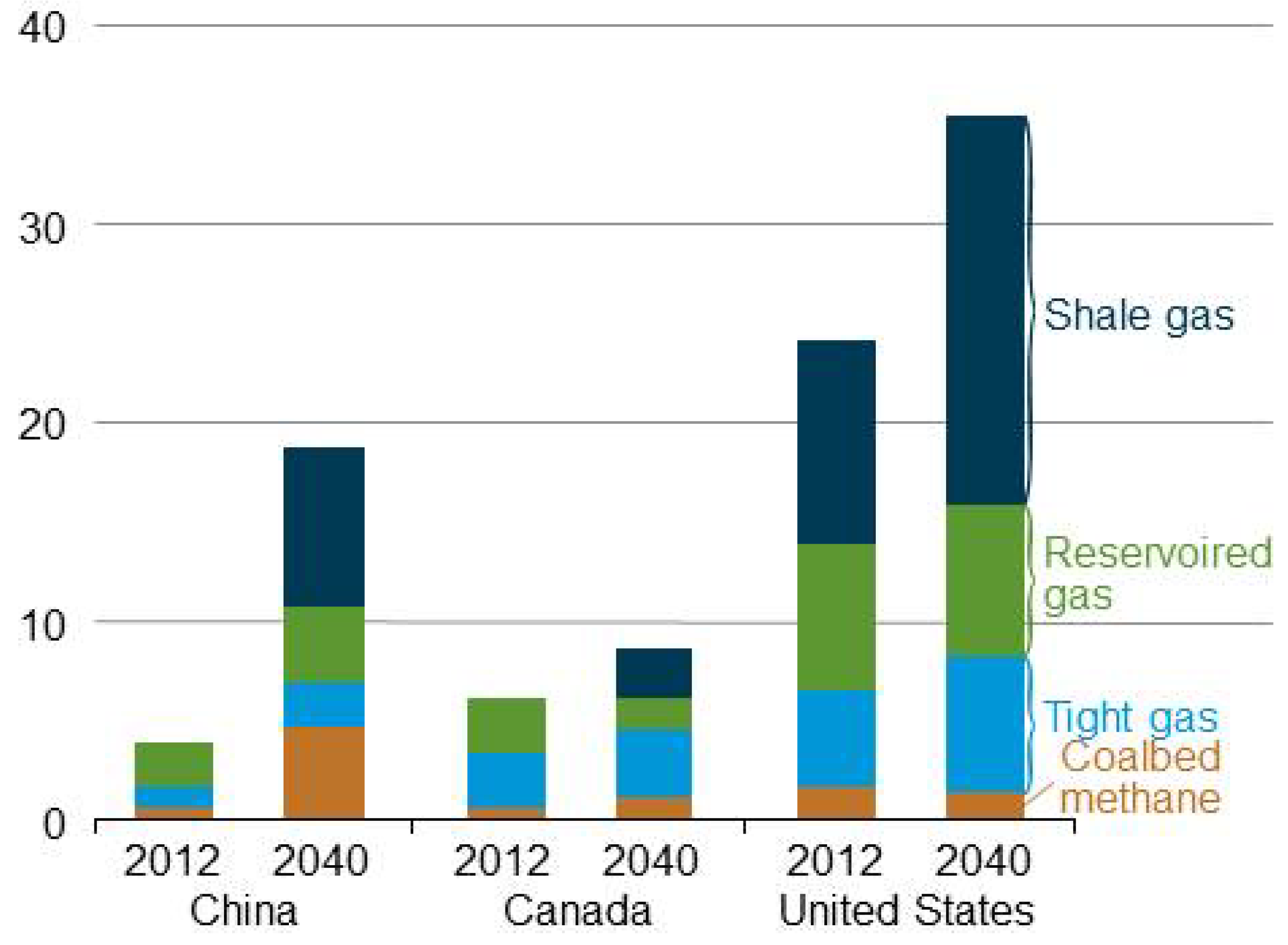
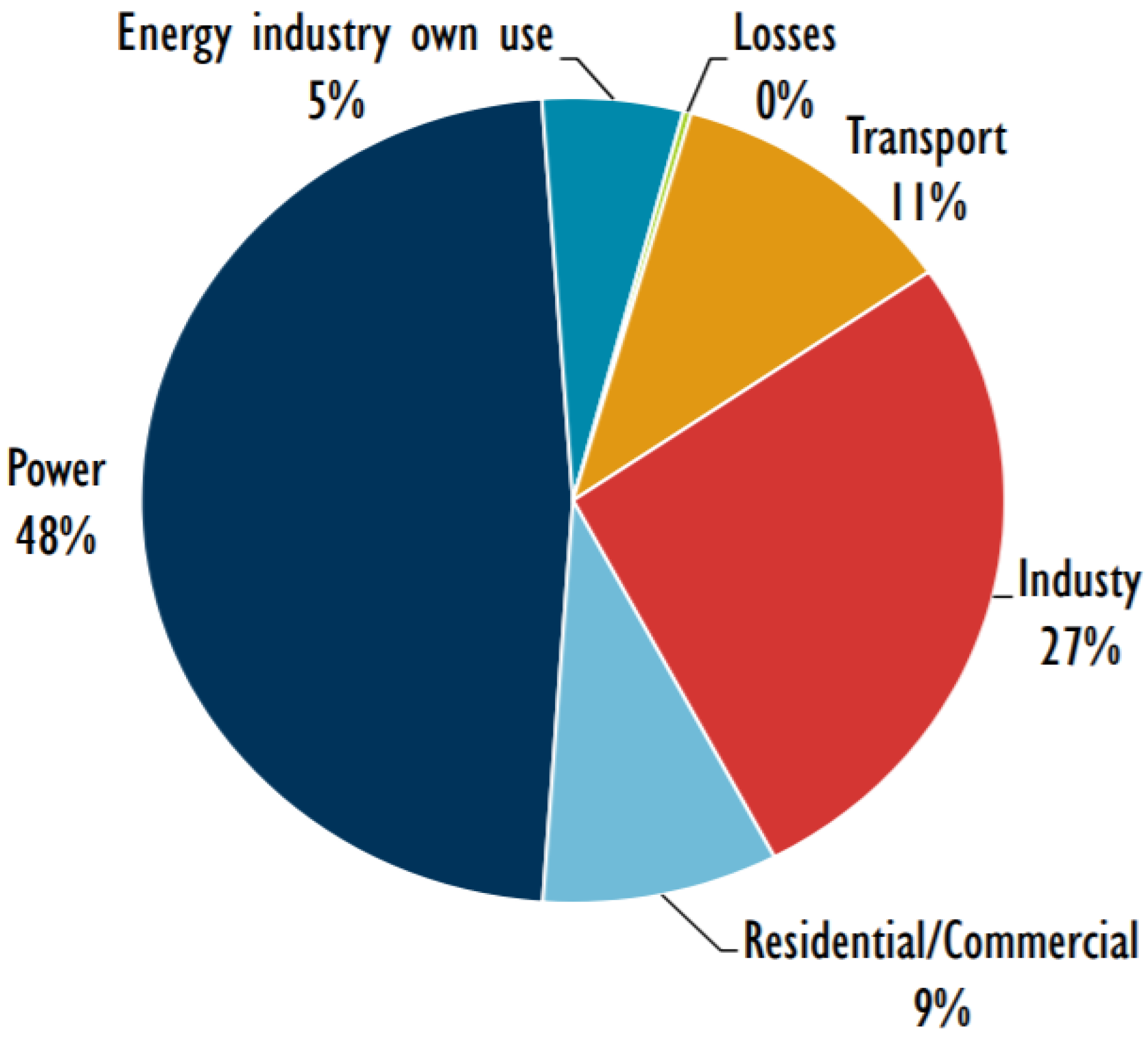

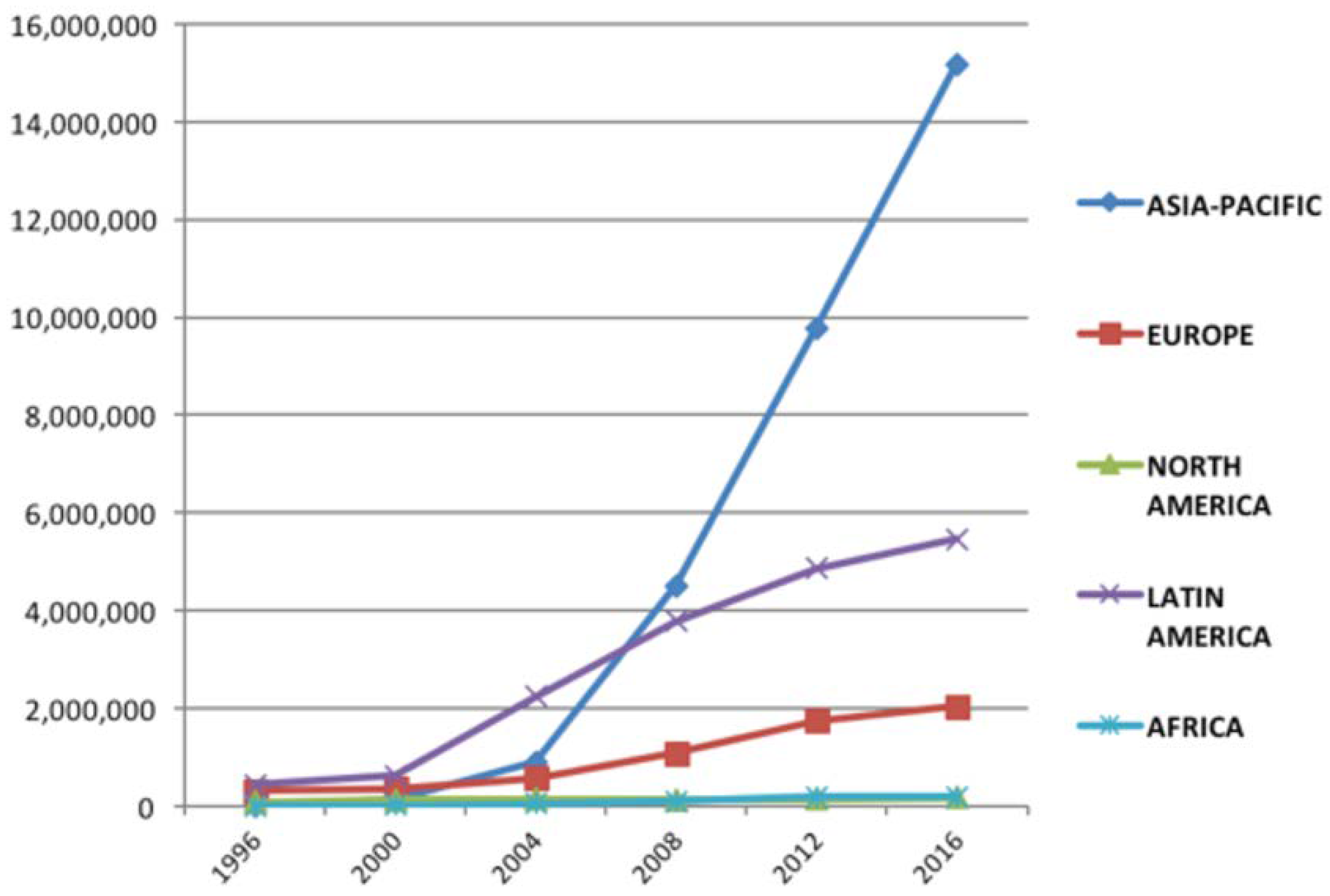
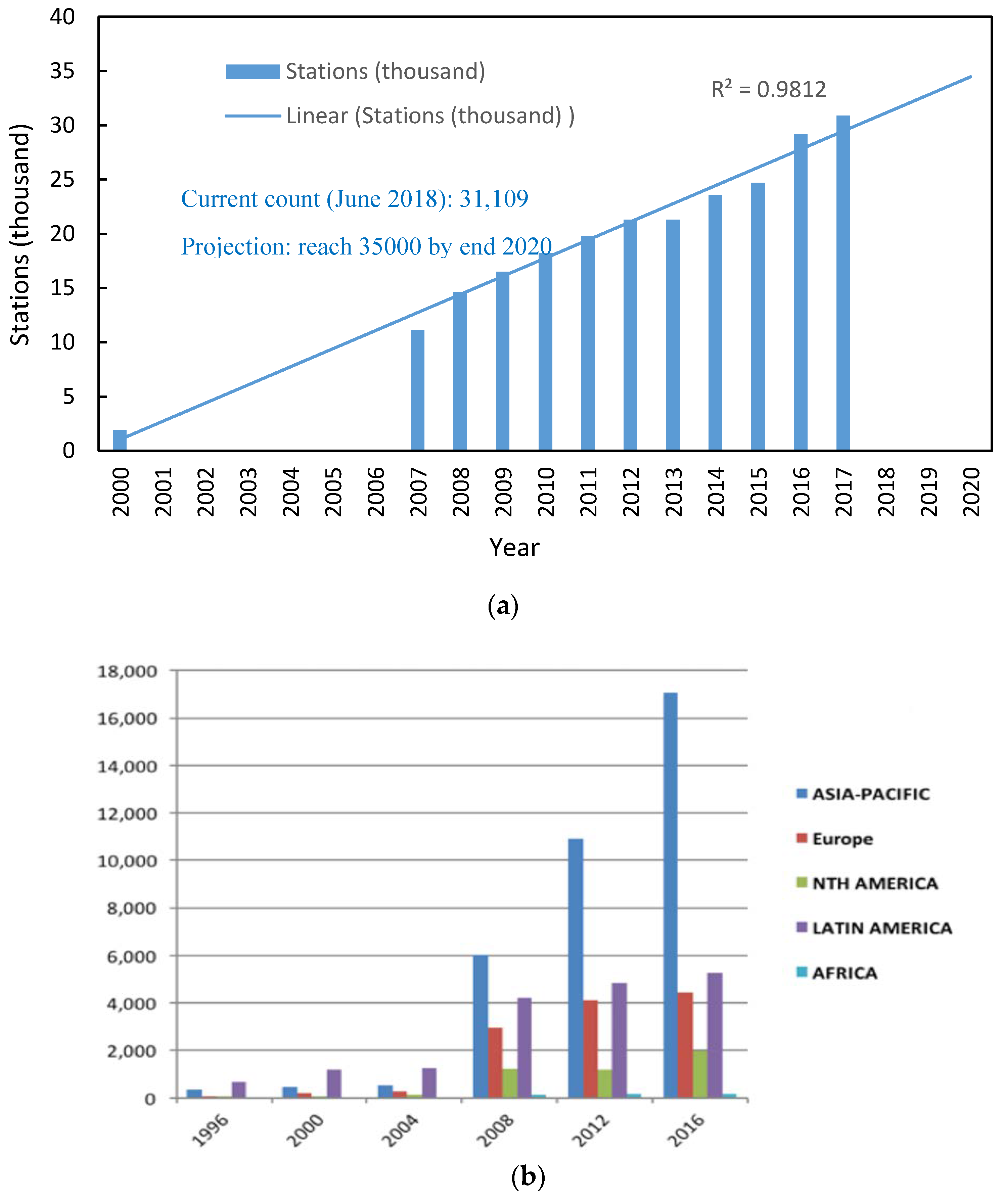
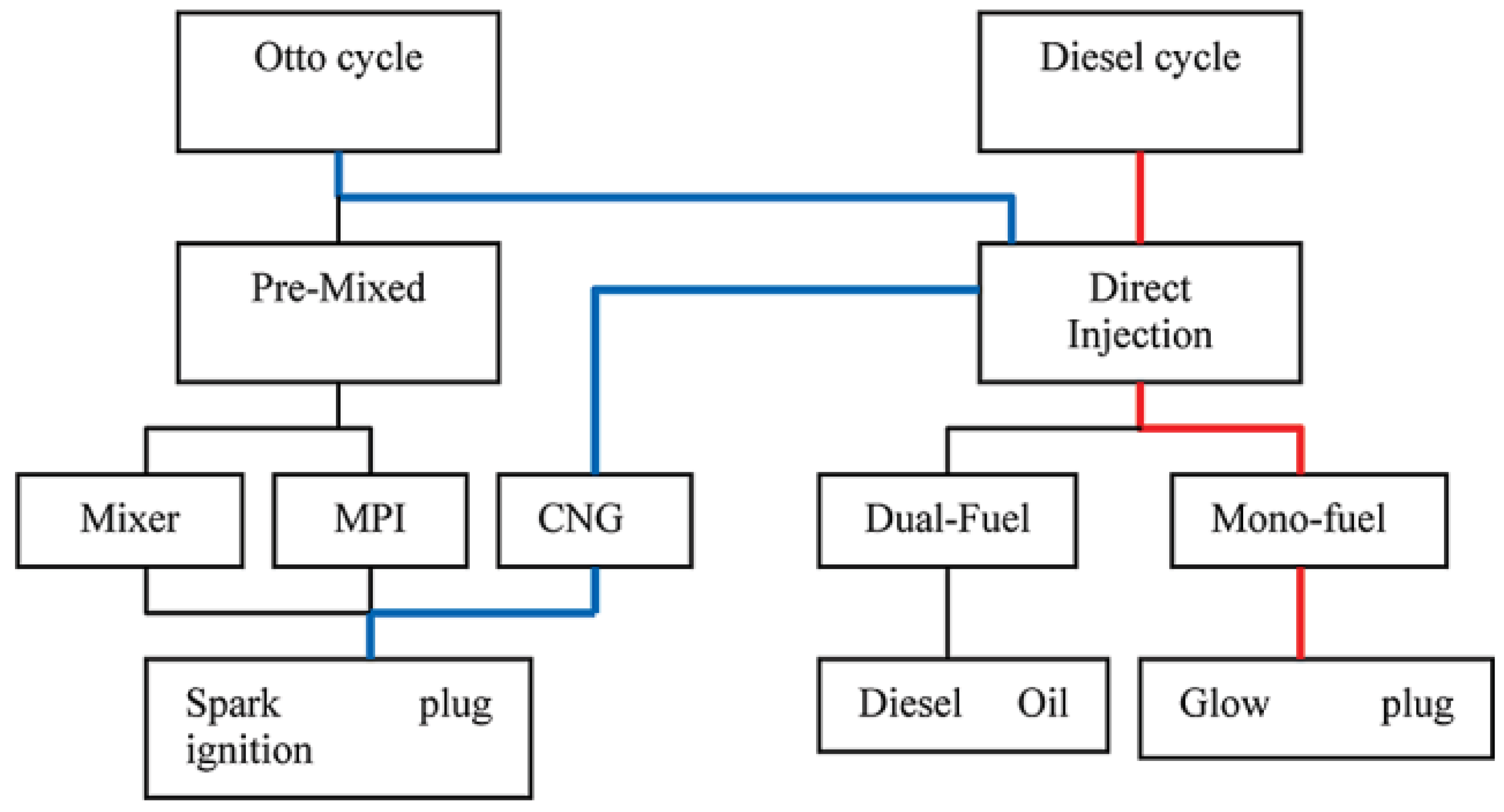
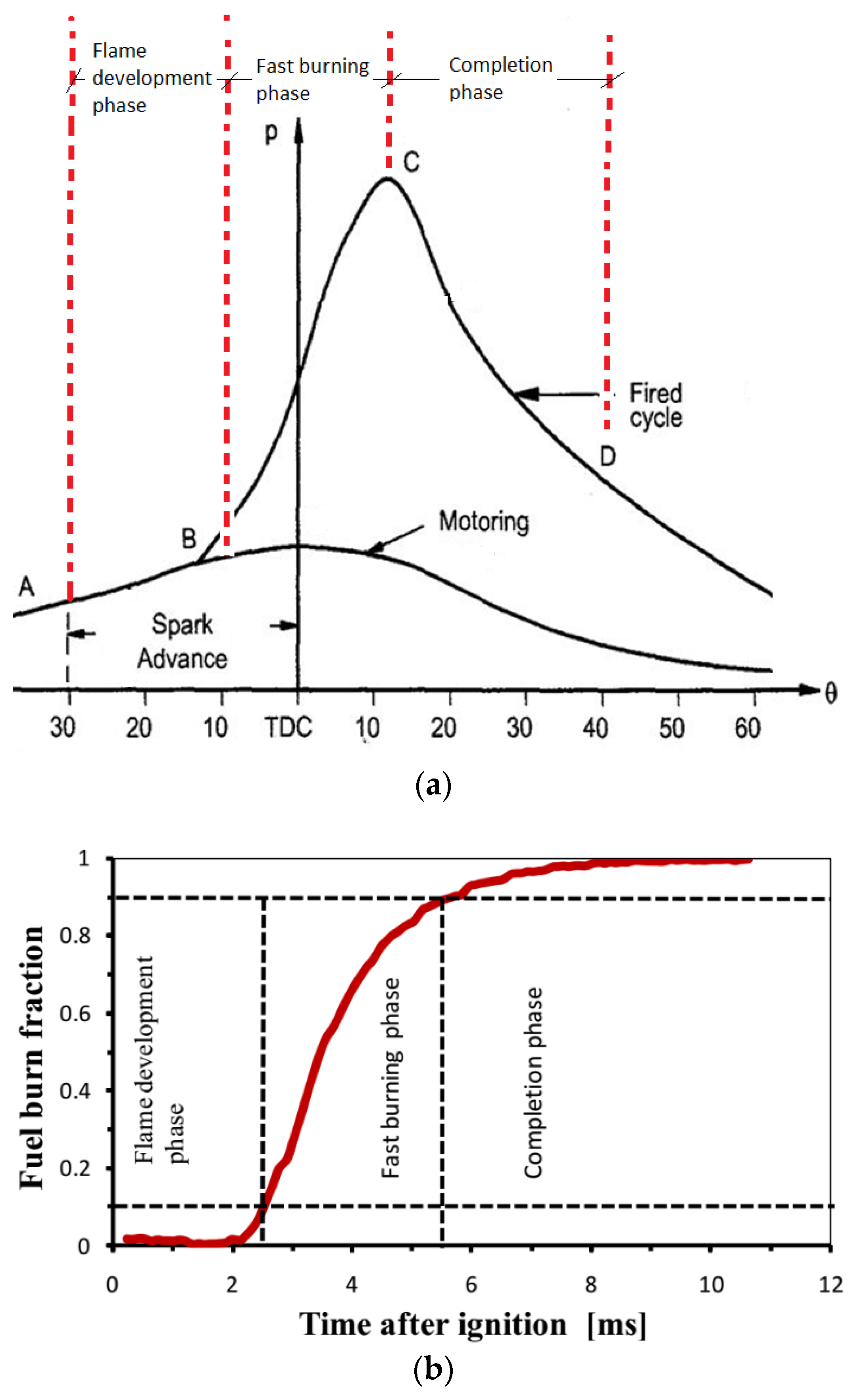
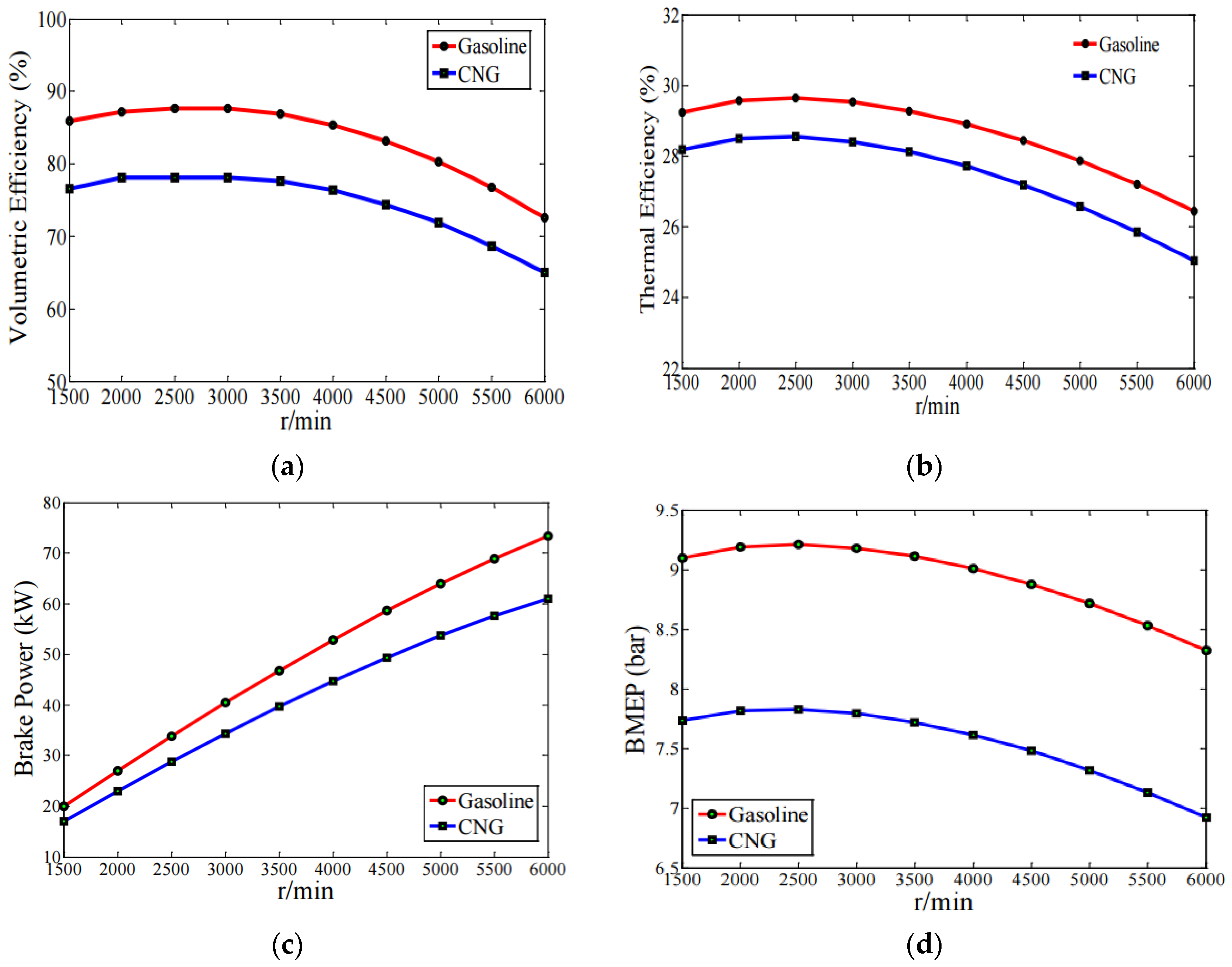
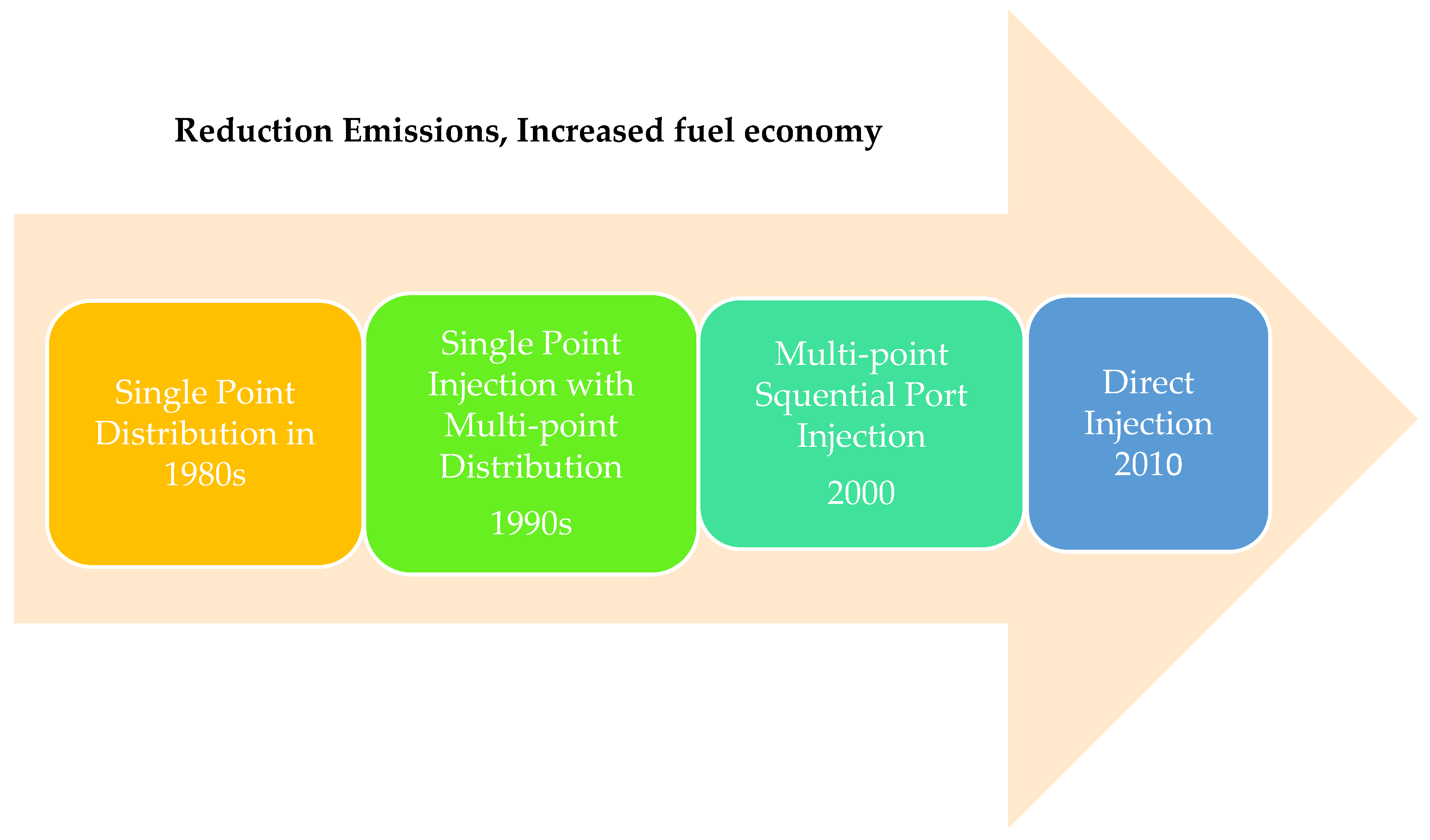
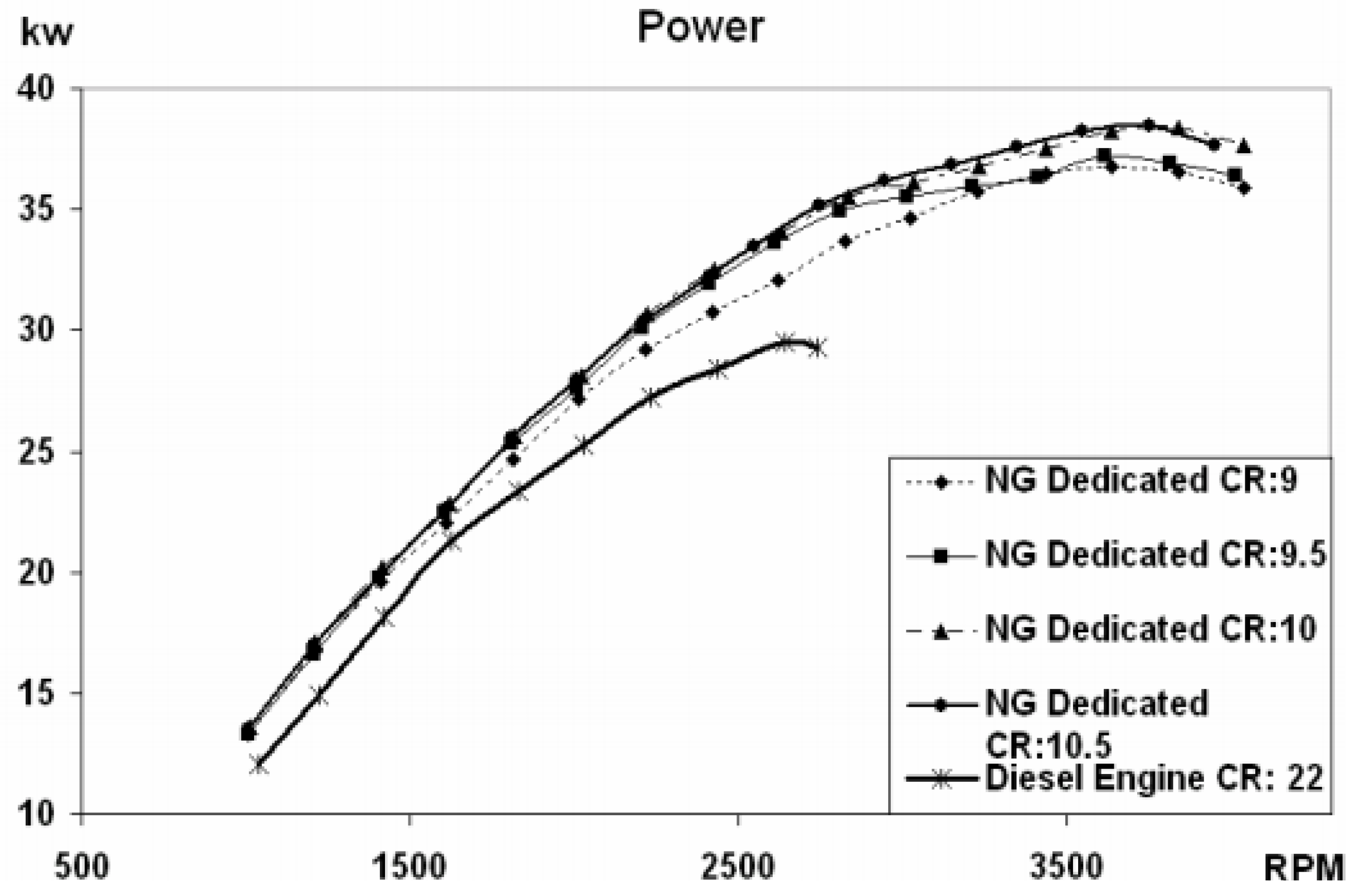
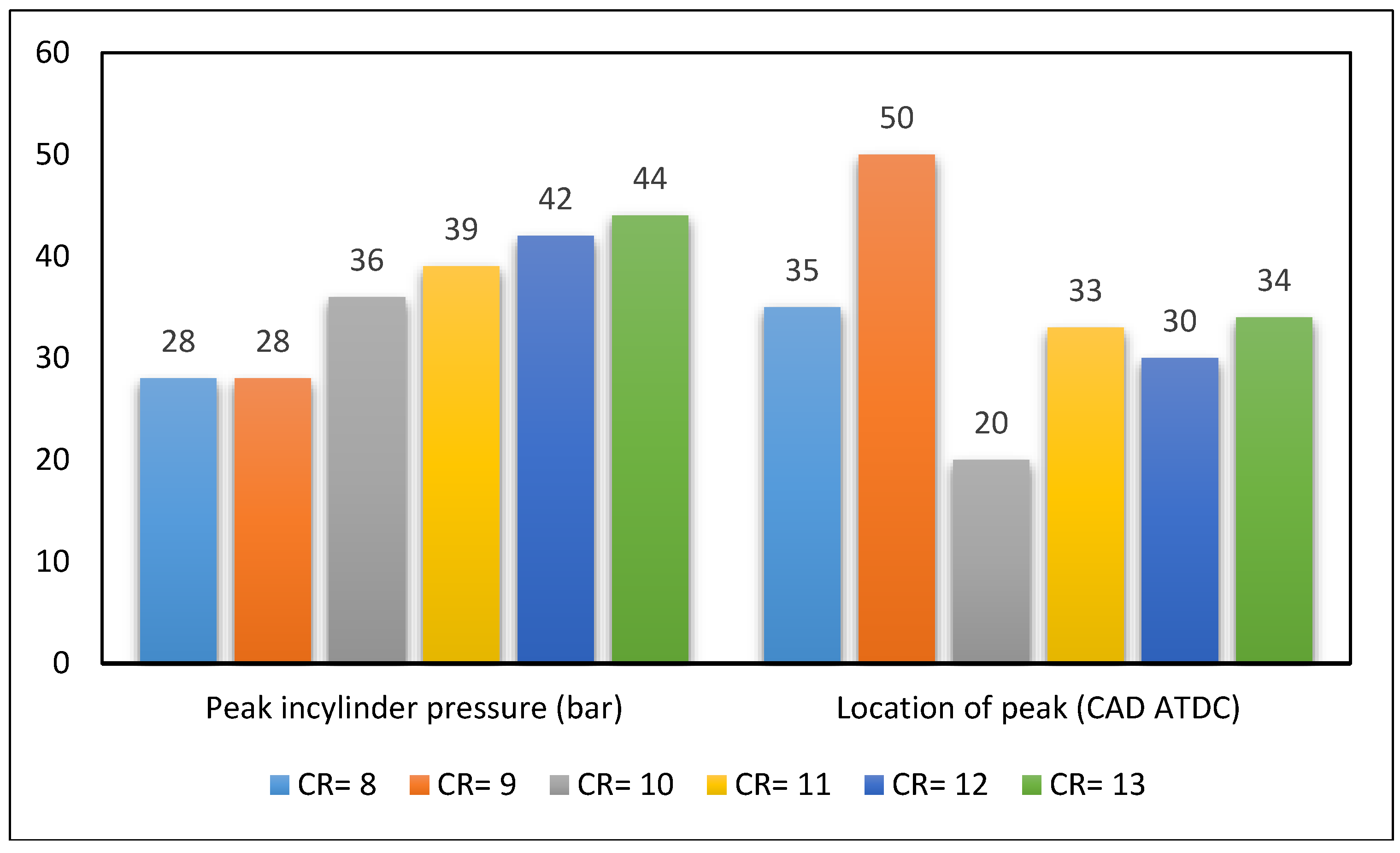
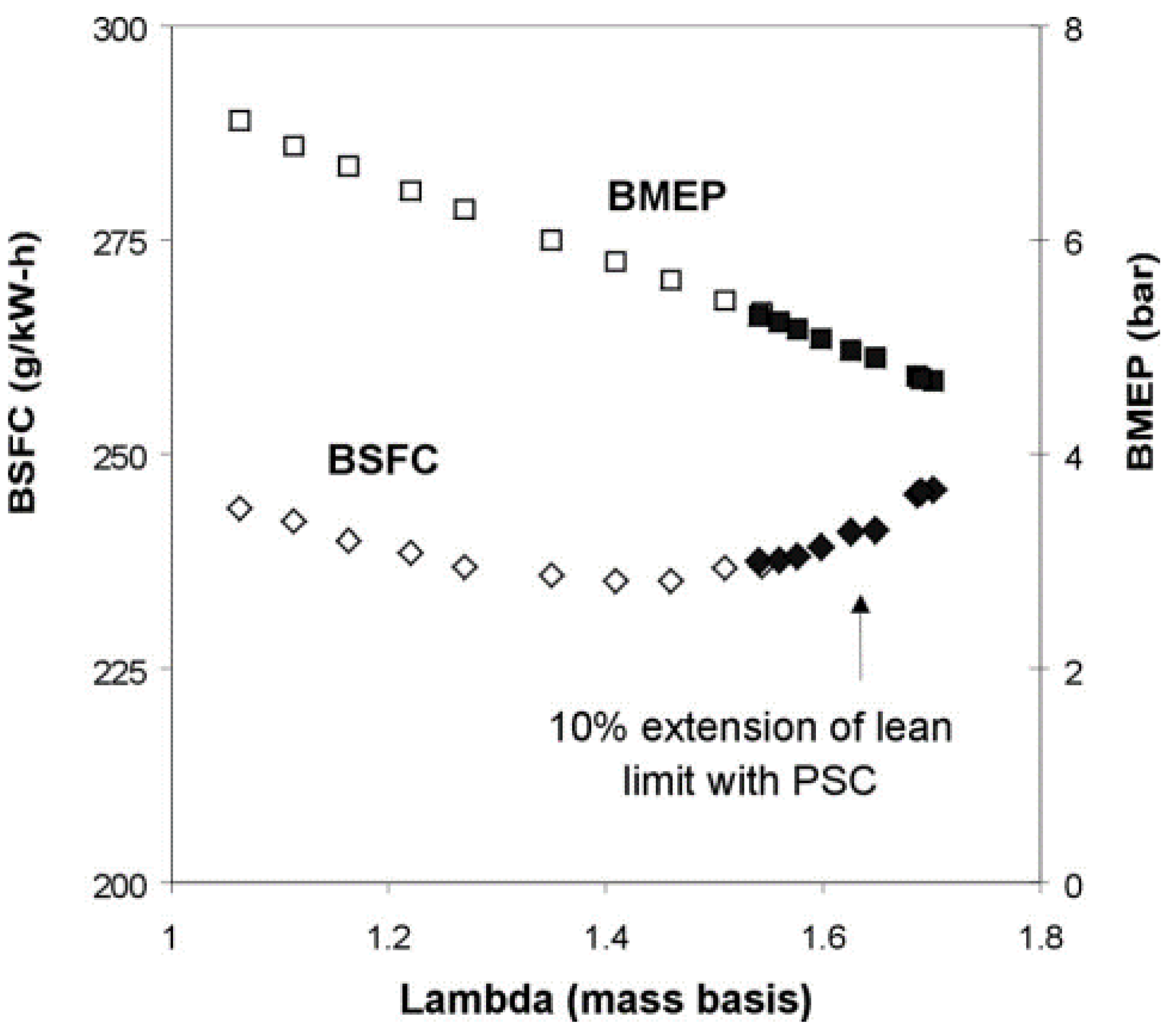
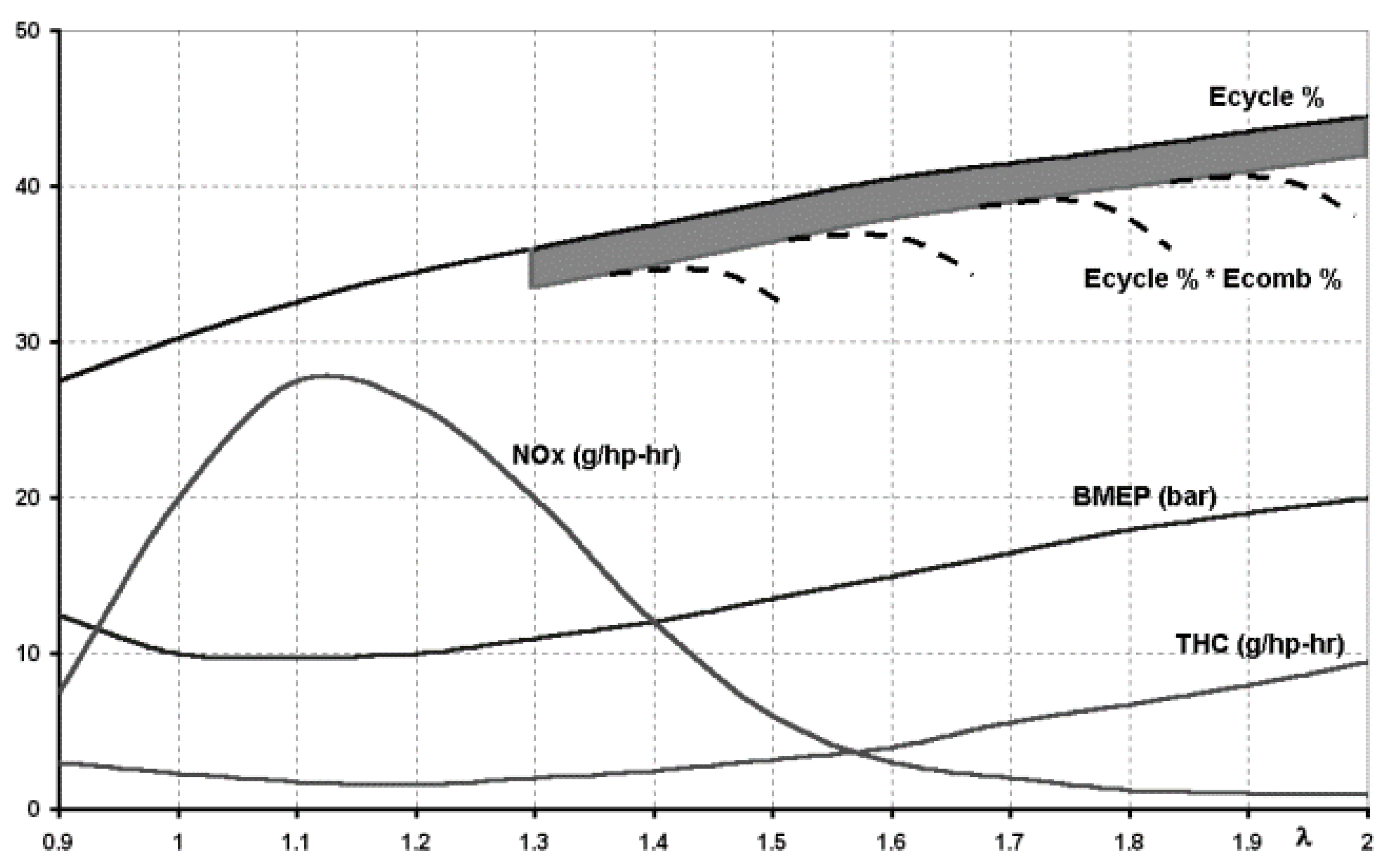
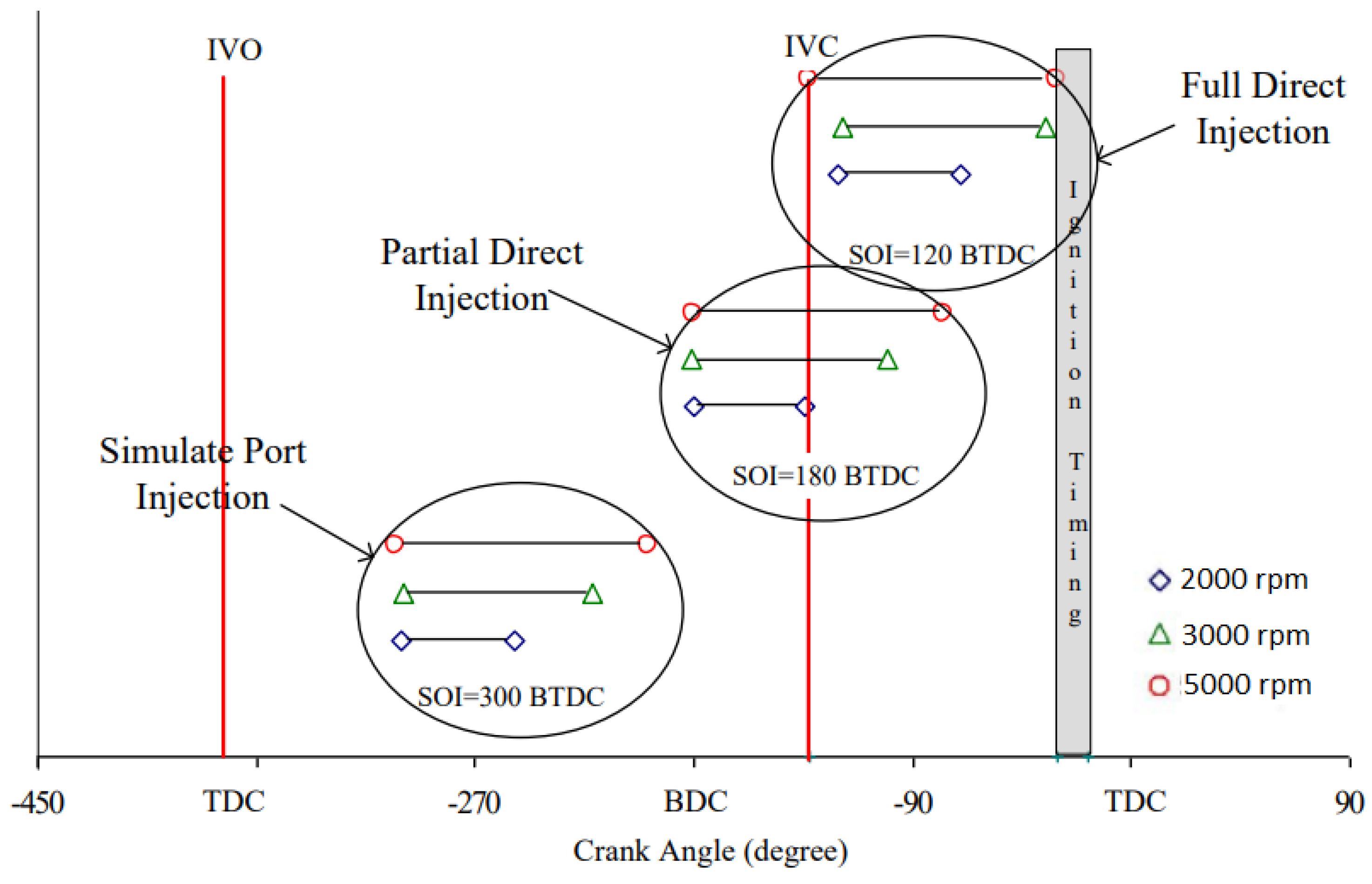

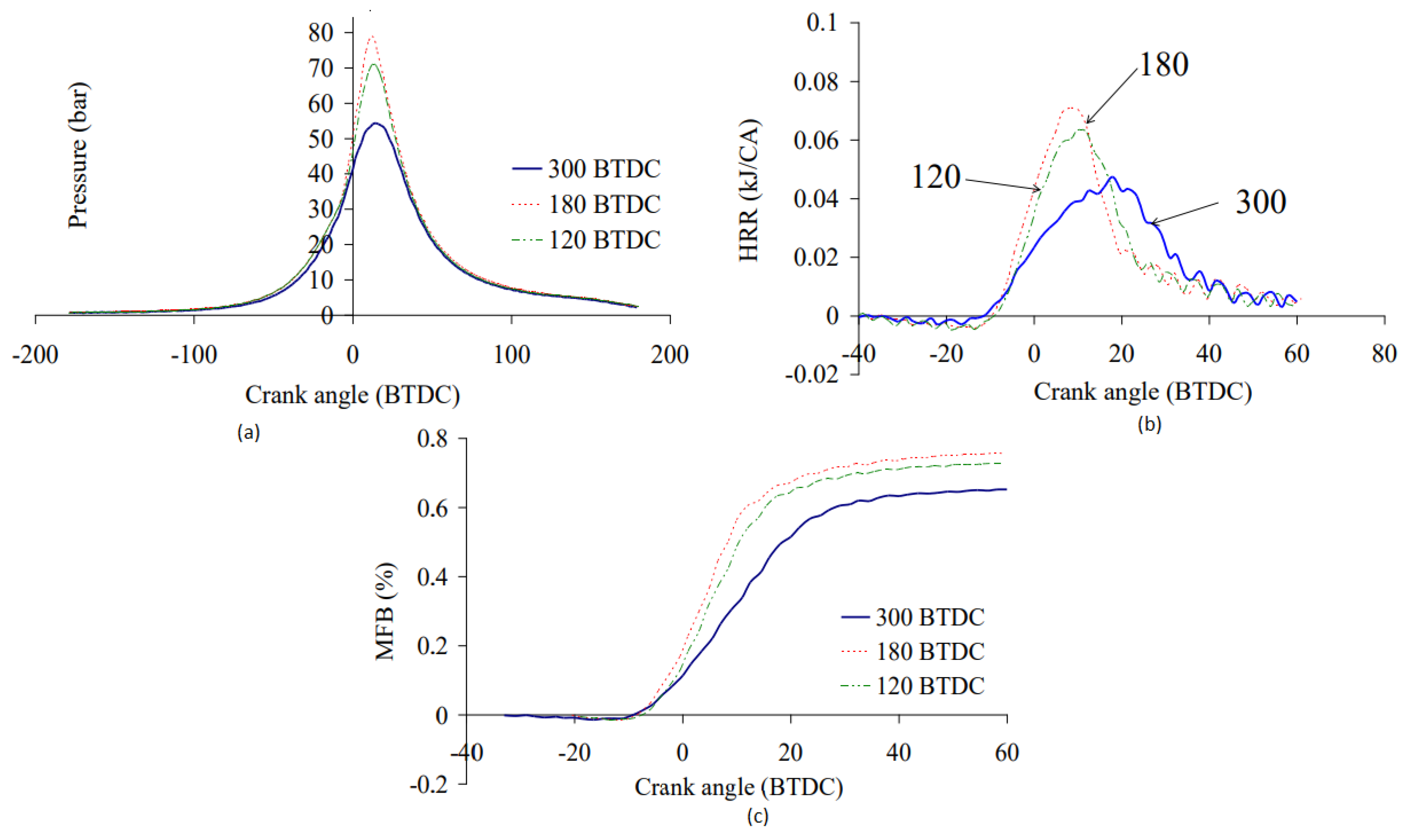
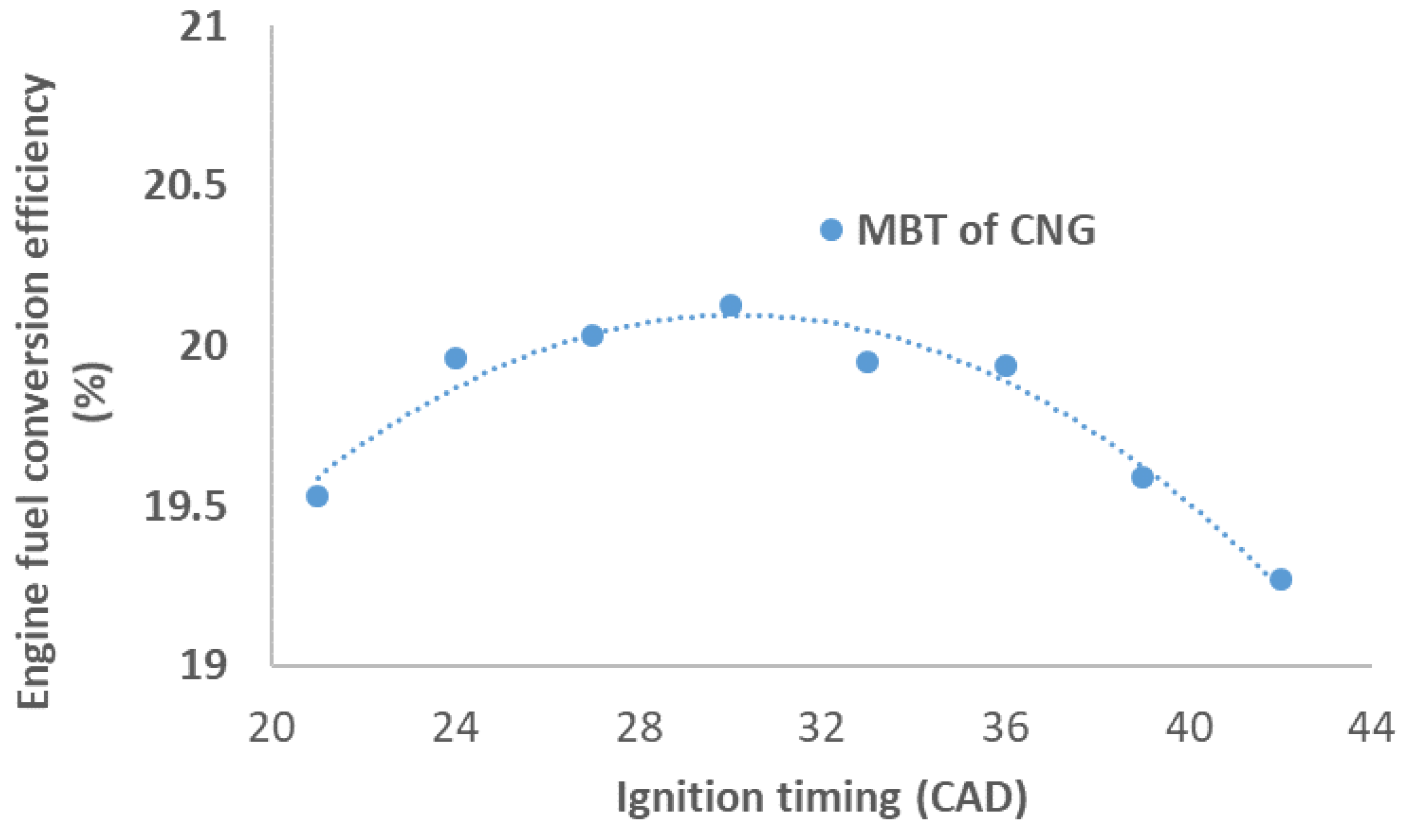

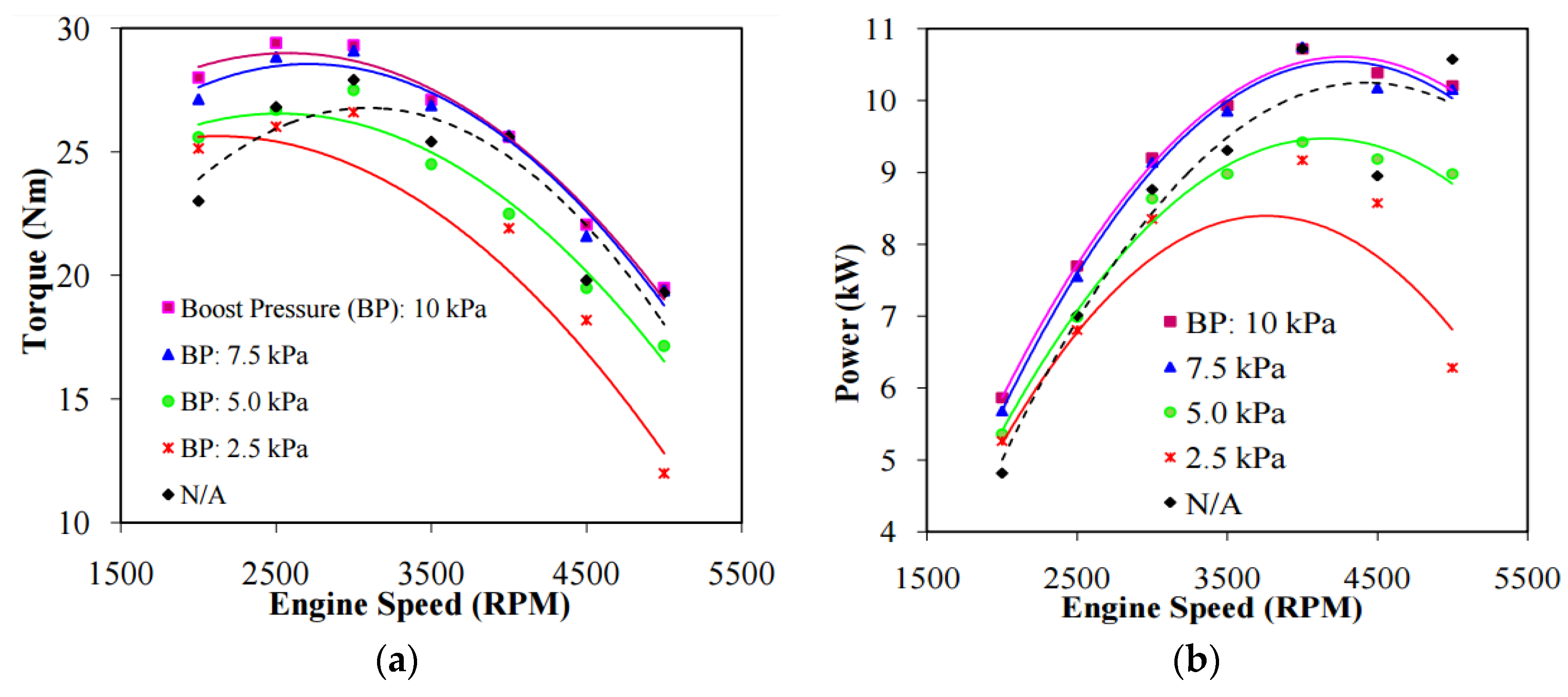
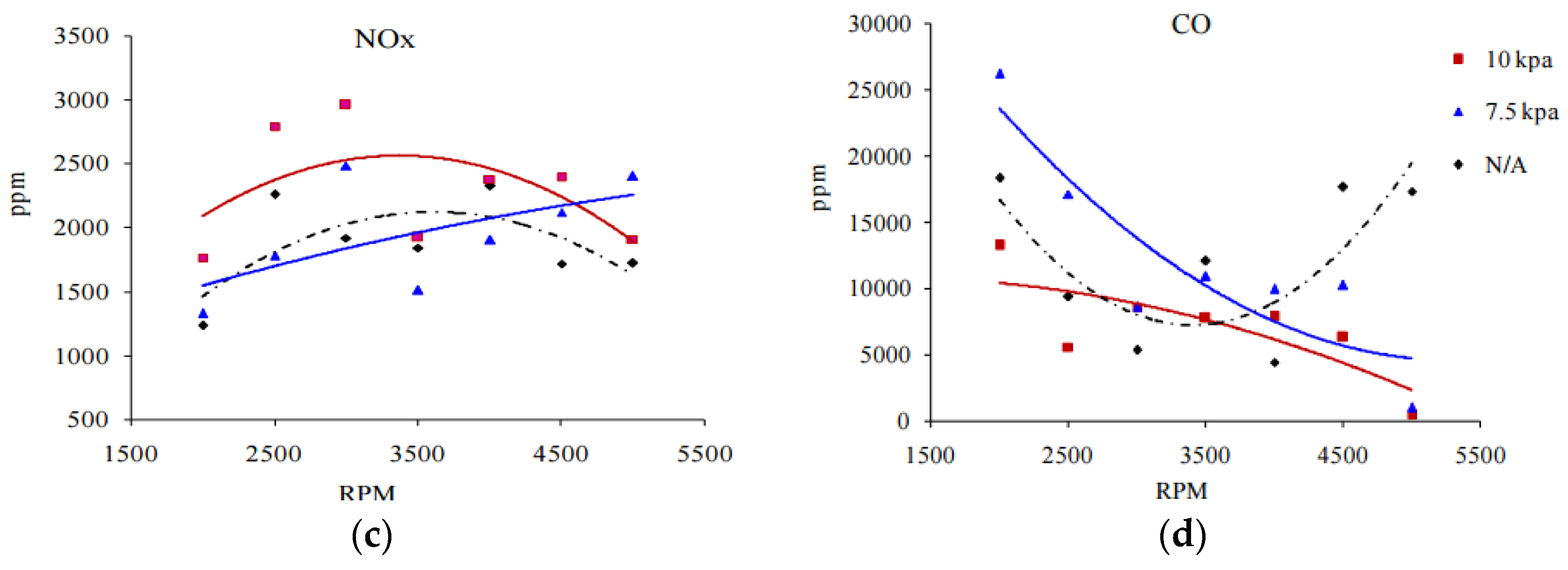

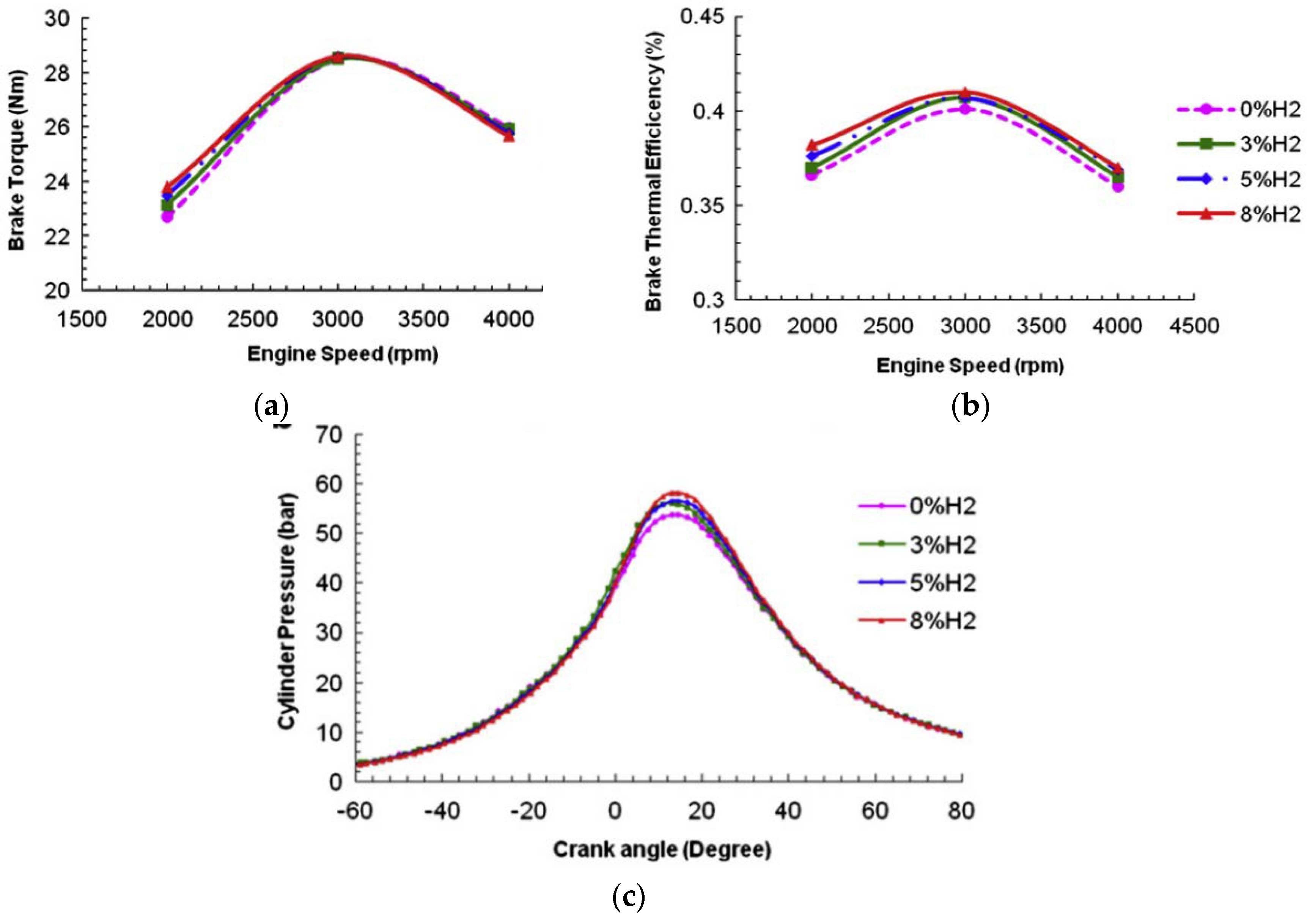

| Fuel Type | Consumption in Percentage | ||
|---|---|---|---|
| 2005 | 2010 | 2015 | |
| Oil | 35.96 | 33.49 | 32.94 |
| Gas | 22.89 | 23.7 | 23.85 |
| Hydro | 6.05 | 6.44 | 6.79 |
| Solar | 1.01 | 0.06 | 0.45 |
| Coal | 28.61 | 29.84 | 29.20 |
| Nuclear | 5.73 | 5.14 | 4.44 |
| Wind | 0.22 | 0.63 | 1.44 |
| Other renewables | 0.54 | 0.70 | 0.89 |
| Region | Proven Reserves in Percentage | ||
|---|---|---|---|
| Year 2005 | Year 2015 | Year 2017 | |
| Middle East | 46.2 | 42.8 | 40.9 |
| Europe and Eurasia | 27.3 | 30.4 | 32.1 |
| Asia-Pacific | 8.2 | 8.4 | 10.0 |
| Africa | 8.9 | 7.5 | 7.1 |
| North America | 5.0 | 6.8 | 5.6 |
| South and Central America | 4.4 | 4.1 | 4.2 |
| Total (in trillion cubic meters) | 157.3 | 186.9 | 193.5 |
| Country | Production Amount (bcm) in 2015 |
|---|---|
| United states | 767.3 |
| Russia | 573.3 |
| Iran | 192.5 |
| Qatar | 181.4 |
| Canada | 163.5 |
| Country | NGV Population | % of NGVs Globally | Data Month/Year |
|---|---|---|---|
| China | 6,080,000 | 23.2% | January 2018 |
| Iran | 4,502,000 | 17.2% | October 2017 |
| India | 3,090,139 | 11.8% | March 2018 |
| Pakistan | 3,000,000 | 11.5% | November 2016 |
| Argentina | 2,185,000 | 8.4% | October 2016 |
| Brazil | 1,859,300 | 7.1% | November 2015 |
| Italy | 1,004,982 | 3.8% | March 2018 |
| Columbia | 571,668 | 2.2% | March 2018 |
| Thailand | 474,486 | 1.8% | July 2016 |
| Uzbekistan | 450,000 | 1.8% | June 2013 |
| Country | NGV Population | Fueling Stations | Ratio of Vehicles to Stations |
|---|---|---|---|
| China | 6,080,000 | 8400 | 724 |
| Iran | 4,502,000 | 2400 | 1875 |
| India | 3,090,139 | 1424 | 2170 |
| Pakistan | 3,000,000 | 3416 | 878 |
| Argentina | 2,185,000 | 2014 | 1085 |
| Brazil | 1,859,300 | 1805 | 1030 |
| Italy | 1,004,982 | 1219 | 824 |
| Columbia | 571,668 | 813 | 703 |
| Thailand | 474,486 | 502 | 945 |
| Uzbekistan | 450,000 | 213 | 2113 |
| Volume Fraction (%) | ||||
|---|---|---|---|---|
| Composition (Formula) | Sample 1 | Sample 2 | Sample 3 | Sample 4 |
| Methane (CH4) | 94 | 92.07 | 94.39 | 91.82 |
| Ethane (C2H6) | 3.3 | 4.66 | 3.29 | 2.91 |
| Propane (C3H8) | 1 | 1.13 | 0.57 | Nil |
| Iso-butane (i-C4H10) | 0.15 | 0.21 | 0.11 | Nil |
| N-butane (n-C4H10) | 0.2 | 0.29 | 0.15 | Nil |
| Iso-pentane (i-C5H12) | 0.02 | 0.1 | 0.05 | Nil |
| N-pentane (n-C5H12) | 0.02 | 0.08 | 0.06 | Nil |
| Nitrogen (N2) | 1 | 1.02 | 0.96 | 4.46 |
| Carbon dioxide (CO2) | 0.3 | 0.26 | 0.28 | 0.81 |
| Hexane (C6 + (C6H14)) | 0.01 | 0.17 | 0.13 | Nil |
| Oxygen (O2 | Nil | 0.01 | <0.01 | Nil |
| Carbon monoxide (CO) | Nil | <0.01 | <0.01 | Nil |
| Total | 100 | 100 | 100 | 100 |
| Properties | CNG | Diesel | Gasoline | |
|---|---|---|---|---|
| Composition, weight % | Carbon | 75.0 | 82.5 [106] 84–87 [107] | 87.0 85–88 (c) [107] |
| Hydrogen | 25.0 | 12.75 [108] 33–16 [107] | 13.0 12–15 [107] | |
| Oxygen | 0.0 | 0.0 | 0.0 | |
| Nitrogen | 0.0 | 0.0 | 0.0 | |
| Molecular weight (g/mol) | 16.04 | 184.43 [106] ~200 [107] | 100–105 [107] | |
| Density at 15 °C and 1 atm (kg/m3) [107] | 0.75 | 803–887 | 719–779 | |
| Specific gravity at 15 °C and 1 atm [107] | 0.424 | 0.81–0.89 | 0.72–0.78 | |
| Stoichiometric air–fuel ratio | Molar Basis | 9.7 | 50.03 1 | 59.5 2 |
| Mass Basis [107] | 17.2 | 14.7 | 14.7 | |
| Stoichiometric volume occupation in cylinder, % | 9.35 | N/A | 2 3 | |
| Lower calorific value | MJ/Nm3 | 38.0 | 36,046 | 32,317 |
| MJ/kg | 47.1 | 44.41 | 42.9 | |
| Stoichiometric mixture energy density (MJ/Nm3) | Mixture aspirated | 2.9 | 3.61 4 | 3.55 5 |
| Air Aspirated | 3.60 | N/A | N/A | |
| Flammability limit, % vol. of fuel in air [107] | Lower | 5.3 | 1 | 1.4 |
| Higher | 15.0 | 6 | 7.6 | |
| Laminar flame velocity (cm/s) | 38 [11] | 82.17 [109] | 48.93 [110] | |
| Latent heat of vaporization at 15 °C, MJ/Nm3 [107] | N/A | 26.08 | 33.5 | |
| Latent heat of vaporization at 15 °C, MJ/kg [107] | N/A | 0.233 | 0.35 | |
| Theoretical adiabatic flame temperature, K | 2220 | 2300–2350 [111] | 2411 | |
| Autoignition temperature, K [107] | 813.15 | 588.7 | 530.37 | |
| Octane number [107] | Research octane number (R) | >127 [112] | N/A | 90–100 |
| Motor octane number (M) | 122 [112] | N/A | 81–90 | |
| Mean ((R + M)/2) | N/A | N/A | 86–94 | |
| Cetane number [107] | N/A | 40–55 | 5–20 | |
| Minimum ignition energy in air, MJ [113] | 0.285 | 0.243 | 0.243 | |
| Storage pressure, MPa | 20.6 | 0.1 | 0.1 | |
| Boiling point (atmospheric pressure), °C | −162 | 250–350 | 35–200 | |
| Natural Gas Transport Type | Year | ||
|---|---|---|---|
| 2000 | 2015 | 2040 | |
| LNG | 26% | 40% | 53% |
| Pipeline | 74% | 60% | 47% |
| Total (tcm) | 525 | 695 | 1150 |
| Properties | CNG | LNG |
|---|---|---|
| Fluid state | Gas | Liquid |
| Pressure | 100 to 250 bar | 1 bar |
| Temperature | 30 °C to −40 °C | −163 °C |
| Loading | Dehydrate, compress | Treat, liquefy, store |
| Loading/Offloading | Gas under pressure | As liquid |
| Compression Ratio | ~250–350:1 | ~600/1 |
| Containment D/t | ~25 to 60 | ~1000 |
| Material | Fine-grain normalized C-Mn steel, Fibre-reinforced plastic (FRP) | Aluminum, Stainless, Ni Steel |
© 2018 by the authors. Licensee MDPI, Basel, Switzerland. This article is an open access article distributed under the terms and conditions of the Creative Commons Attribution (CC BY) license (http://creativecommons.org/licenses/by/4.0/).
Share and Cite
Chala, G.T.; Abd Aziz, A.R.; Hagos, F.Y. Natural Gas Engine Technologies: Challenges and Energy Sustainability Issue. Energies 2018, 11, 2934. https://doi.org/10.3390/en11112934
Chala GT, Abd Aziz AR, Hagos FY. Natural Gas Engine Technologies: Challenges and Energy Sustainability Issue. Energies. 2018; 11(11):2934. https://doi.org/10.3390/en11112934
Chicago/Turabian StyleChala, Girma T., Abd Rashid Abd Aziz, and Ftwi Y. Hagos. 2018. "Natural Gas Engine Technologies: Challenges and Energy Sustainability Issue" Energies 11, no. 11: 2934. https://doi.org/10.3390/en11112934
APA StyleChala, G. T., Abd Aziz, A. R., & Hagos, F. Y. (2018). Natural Gas Engine Technologies: Challenges and Energy Sustainability Issue. Energies, 11(11), 2934. https://doi.org/10.3390/en11112934





